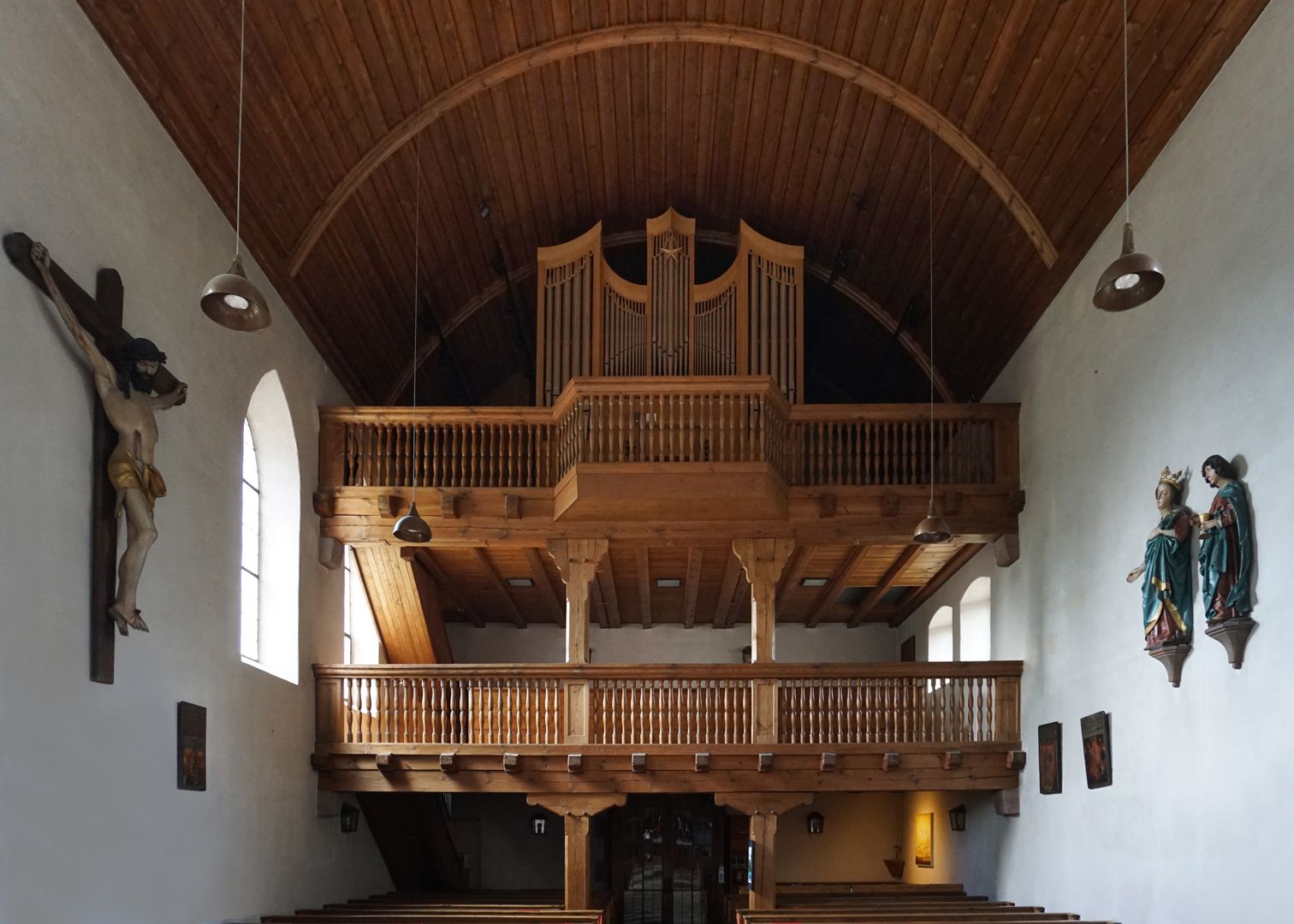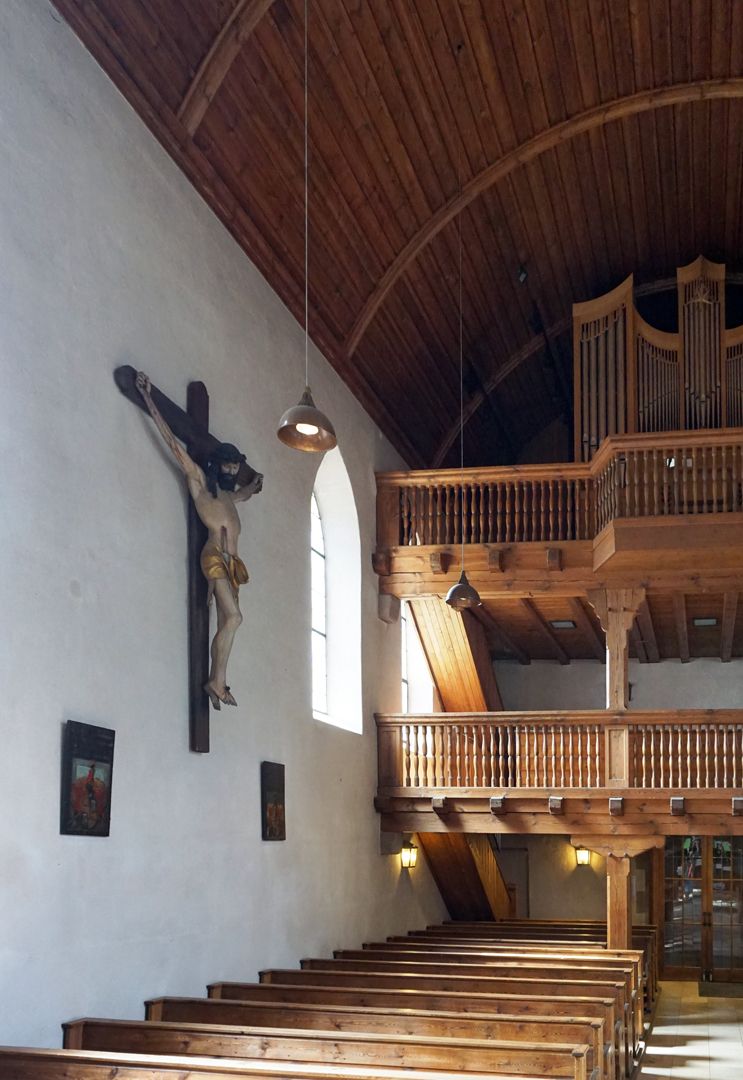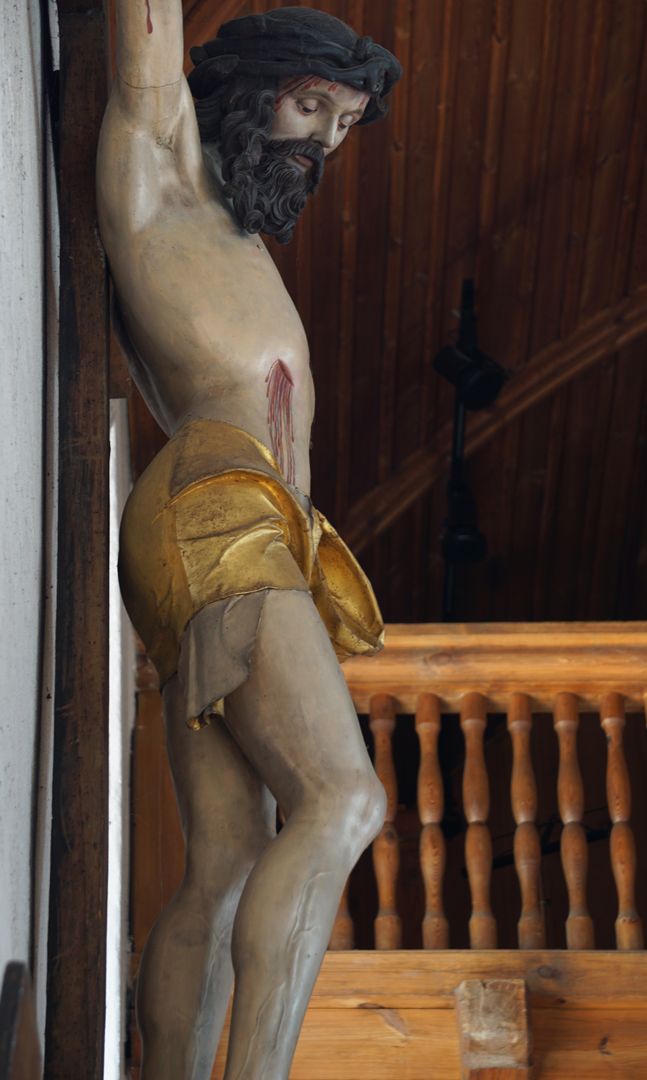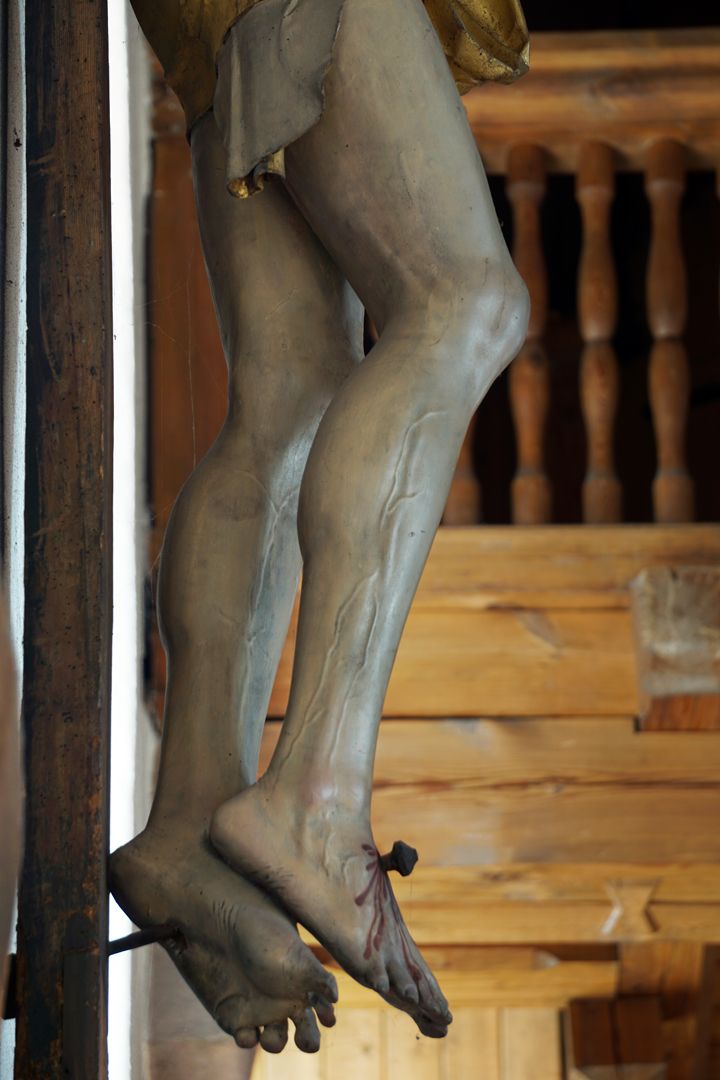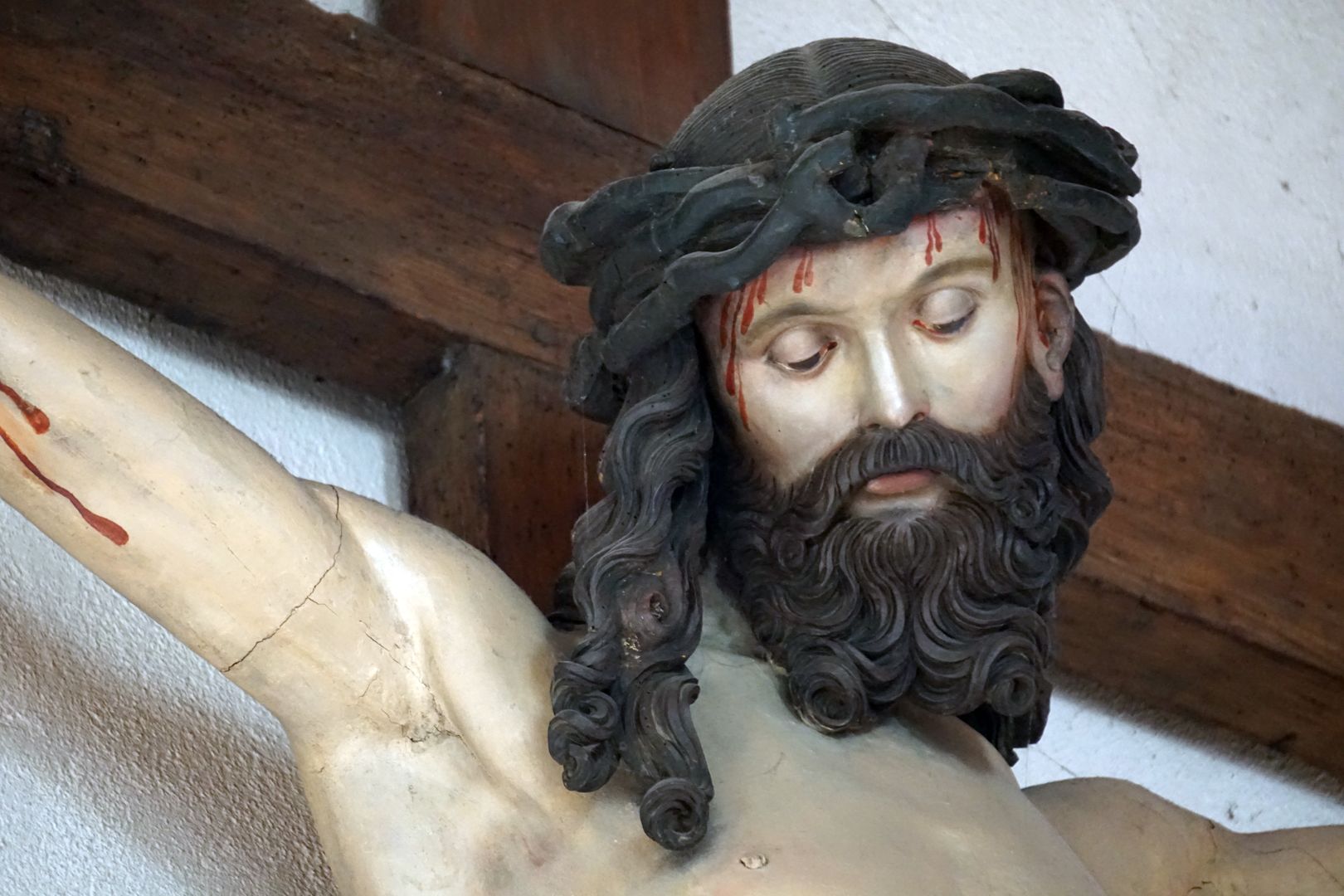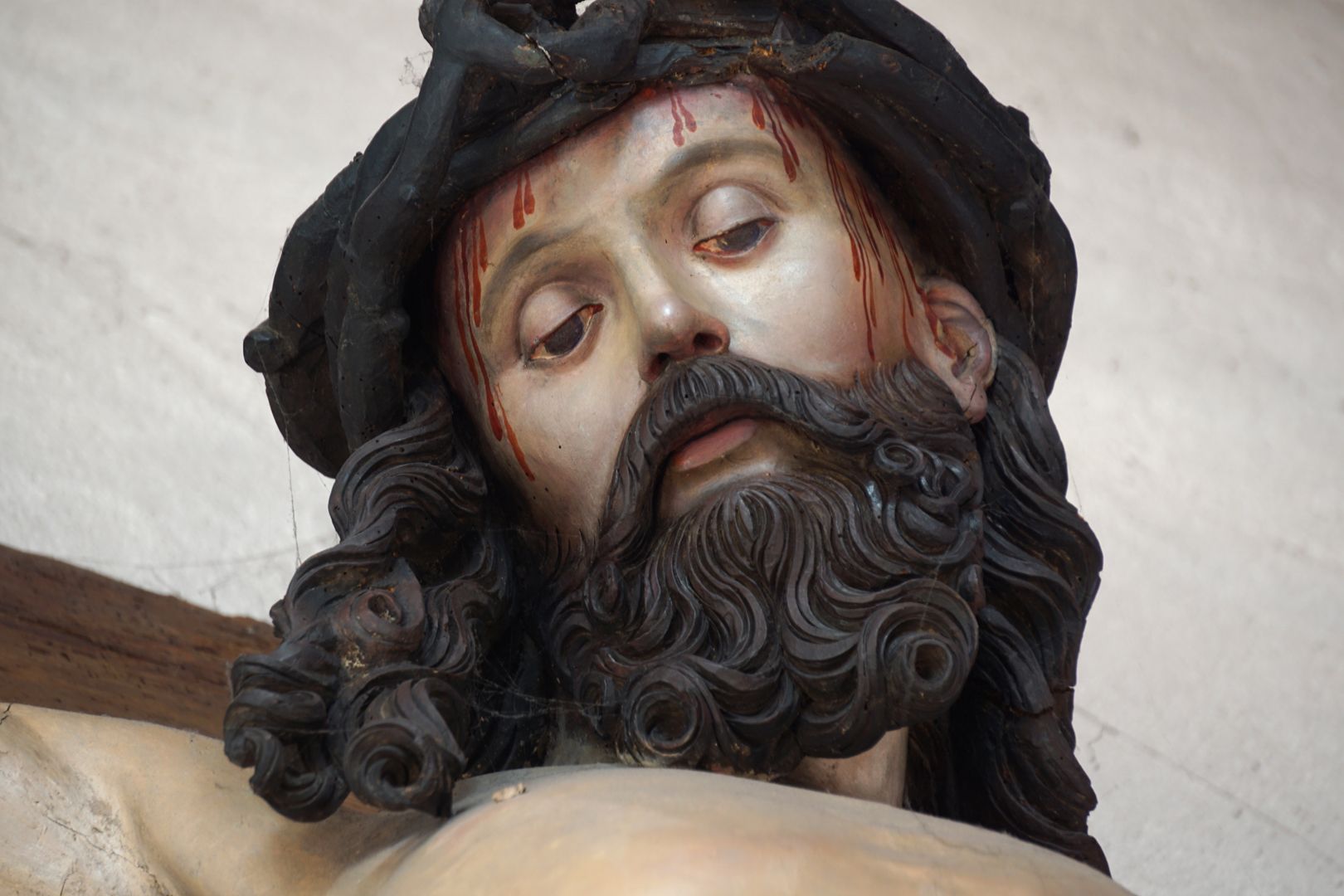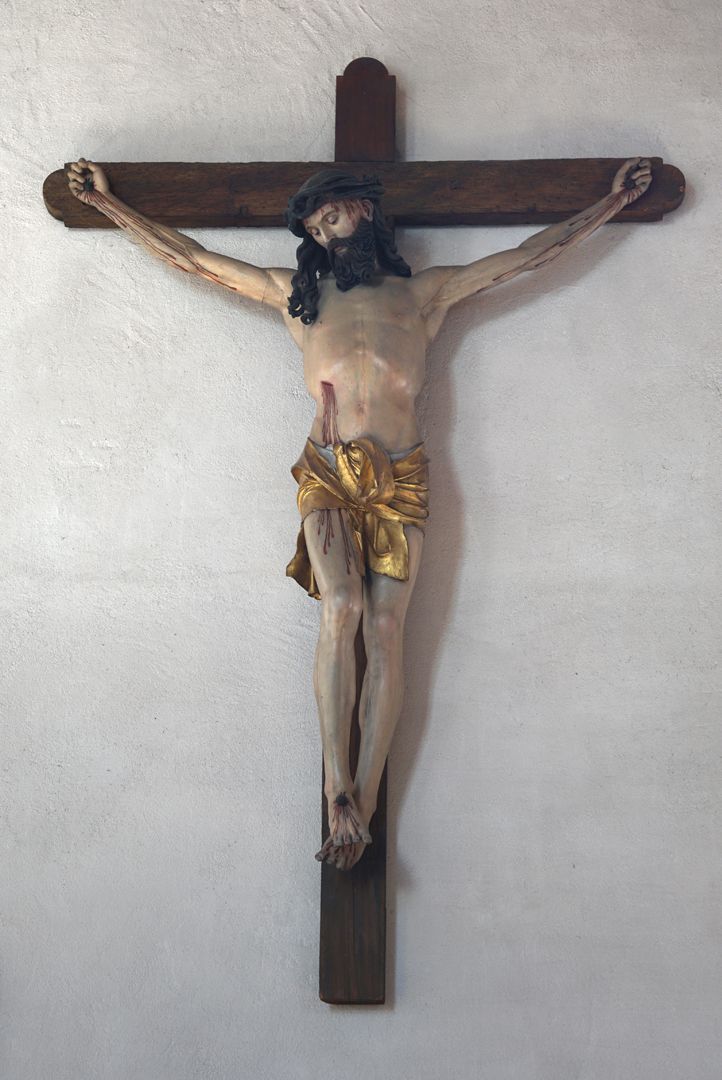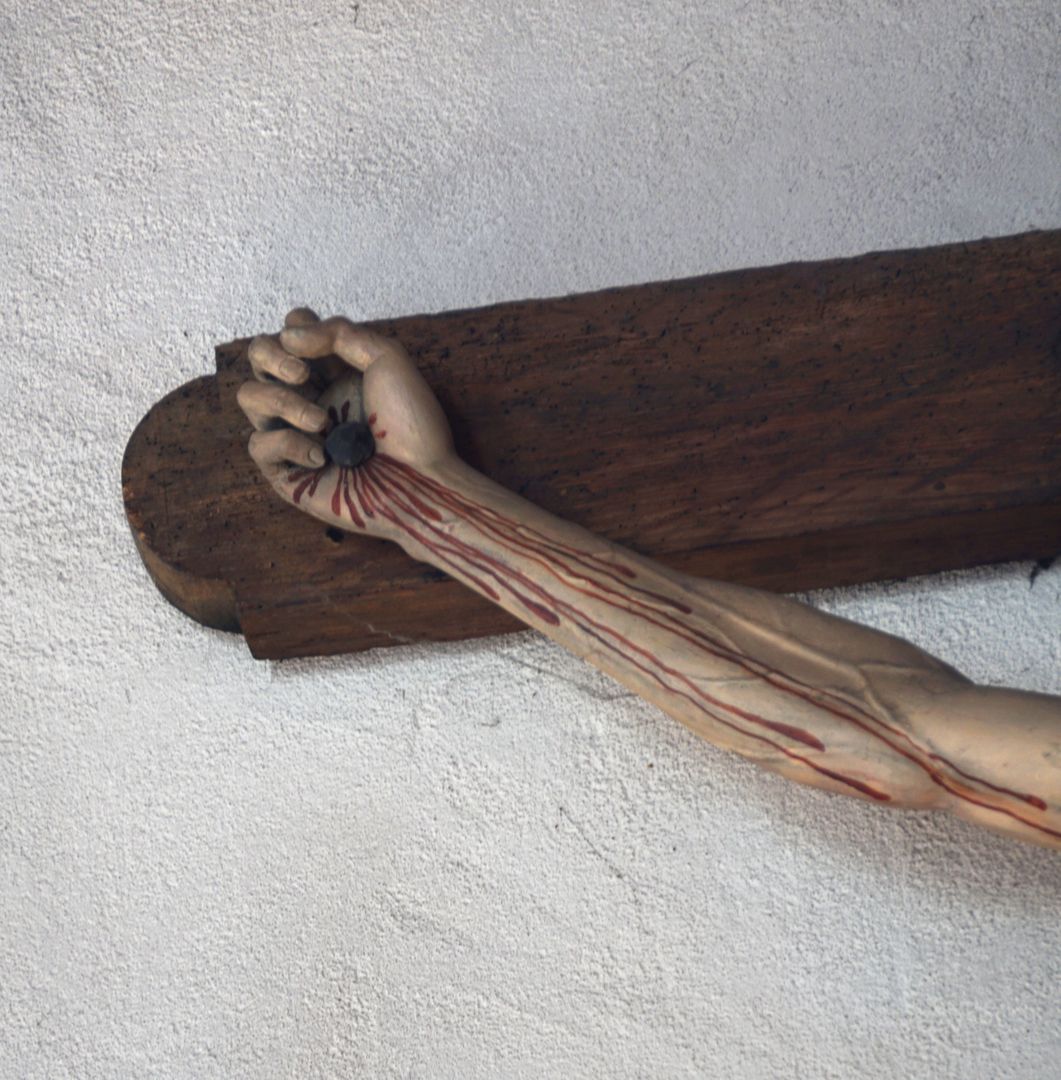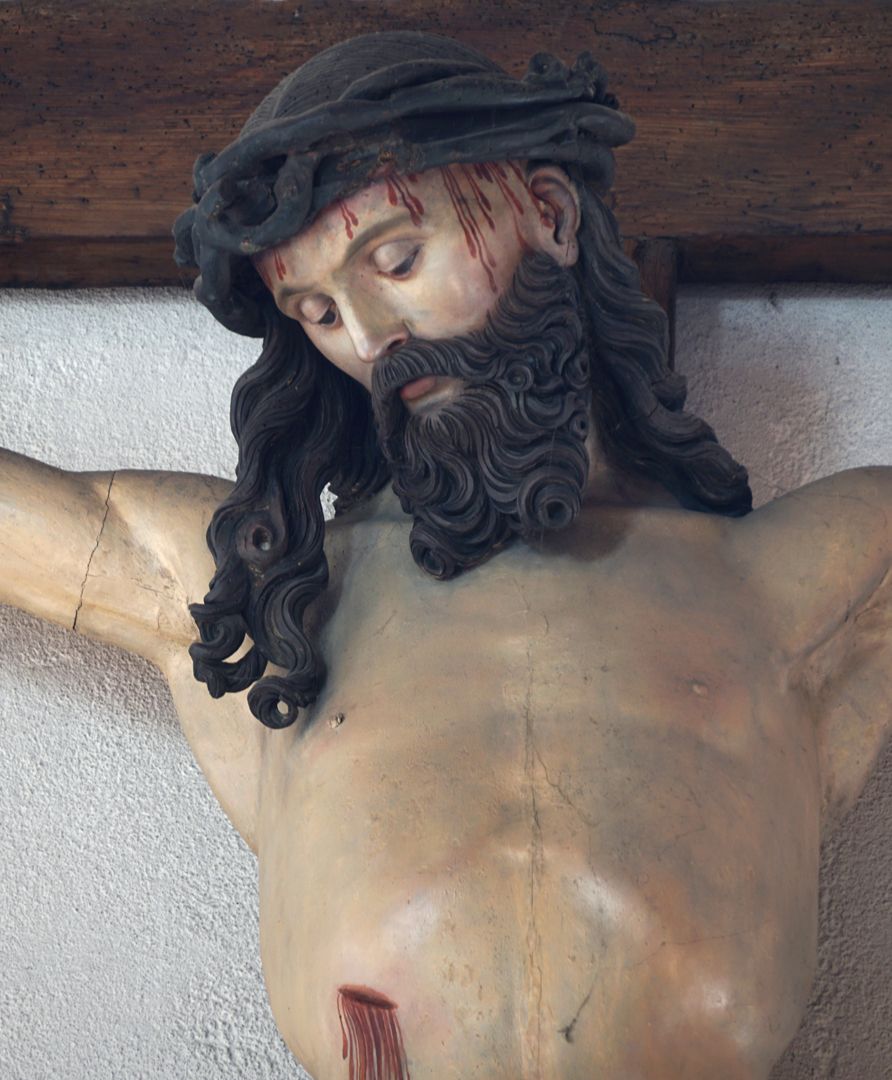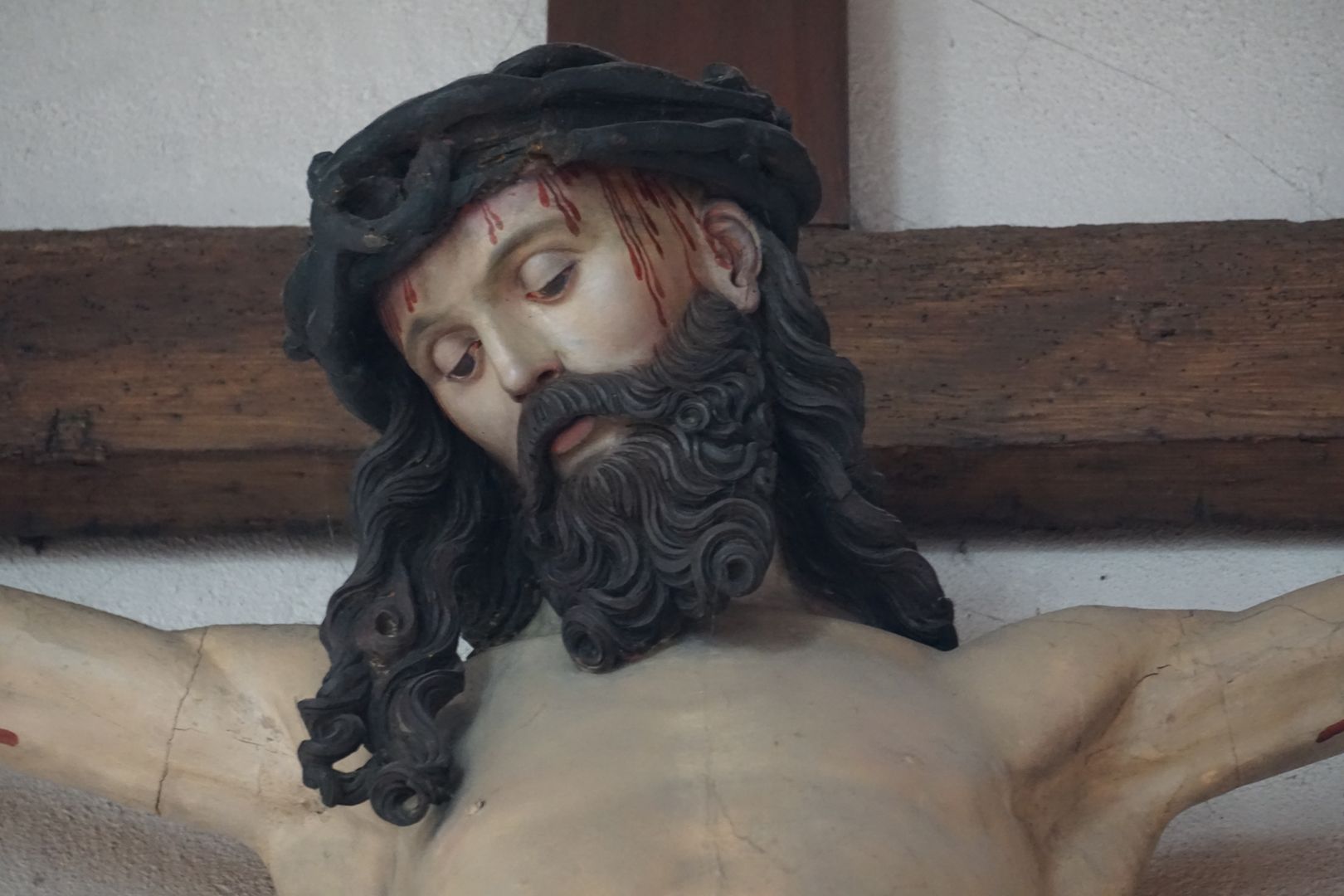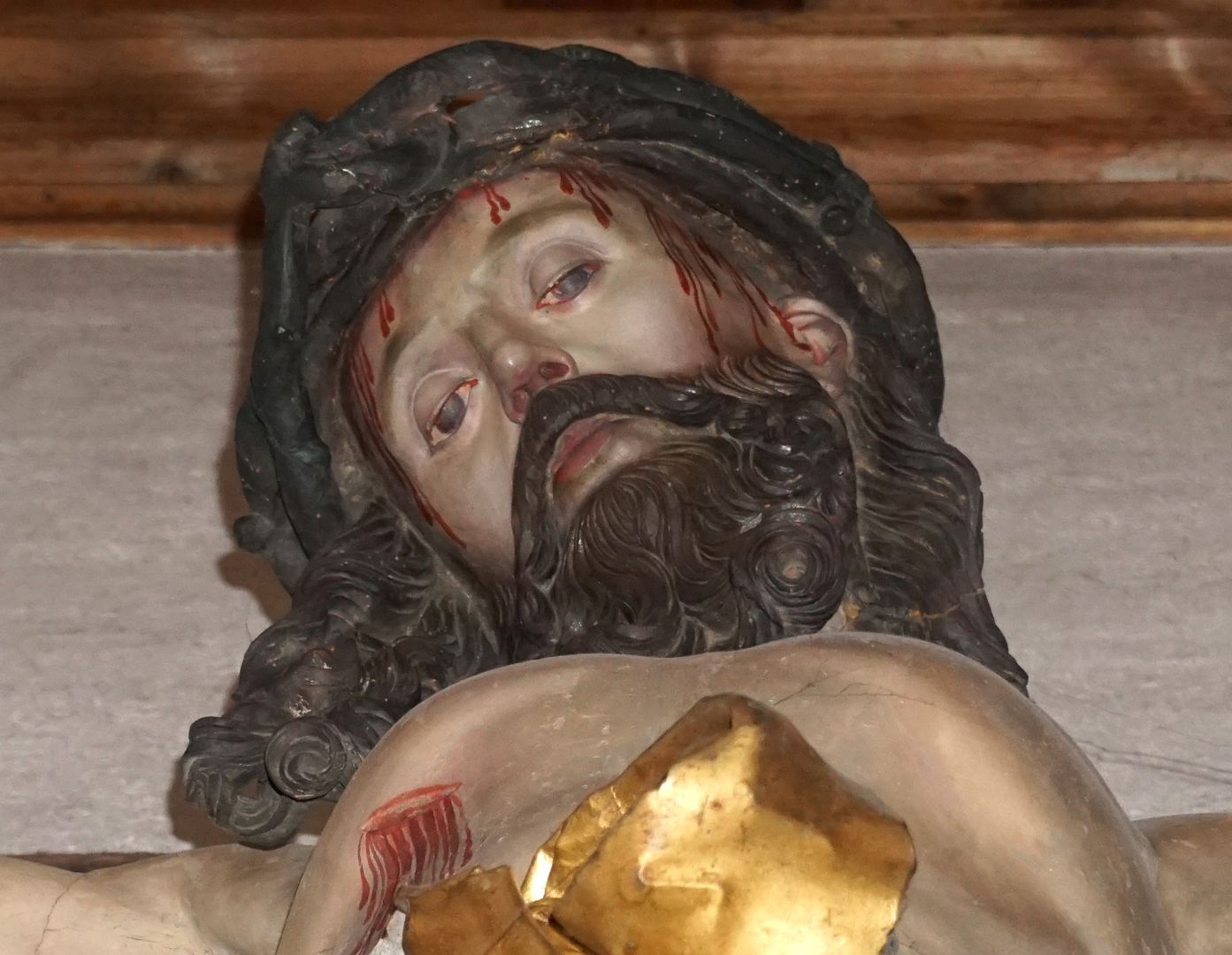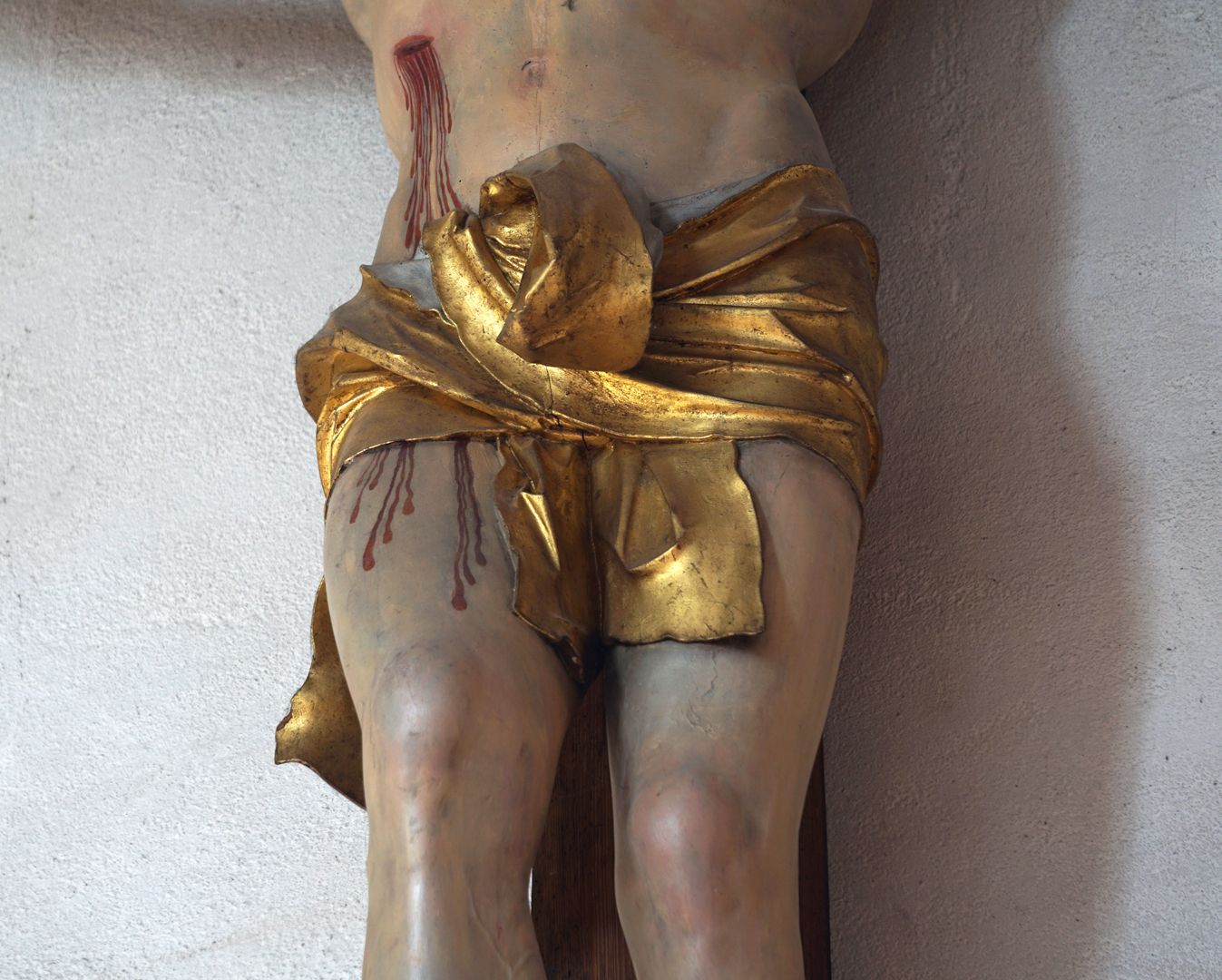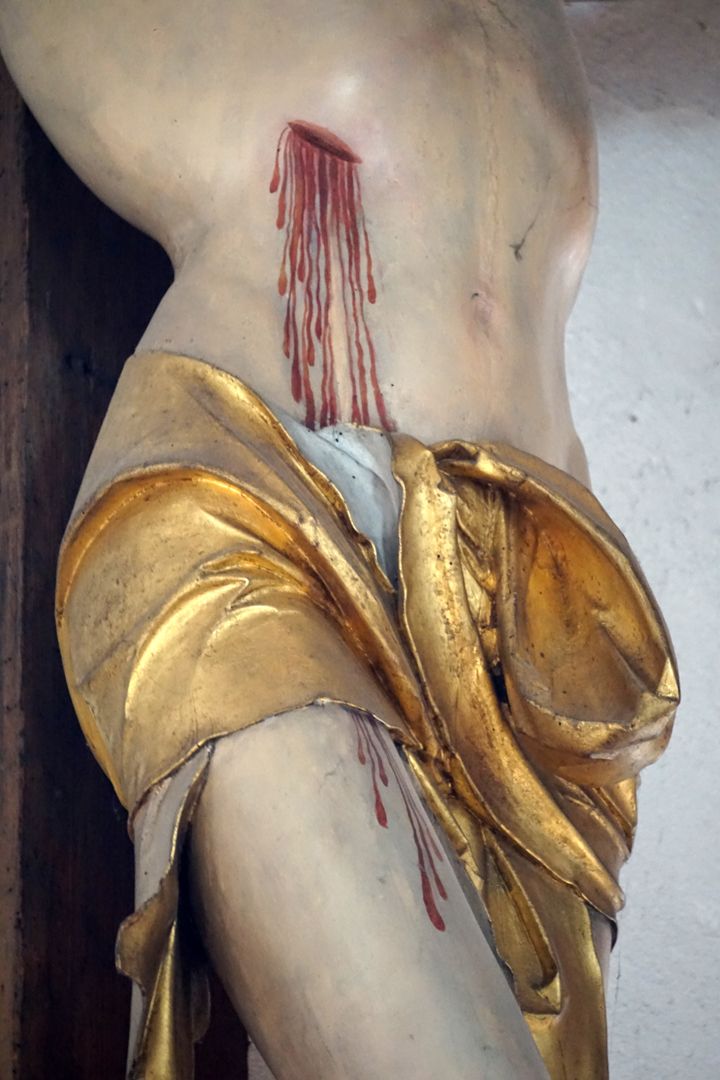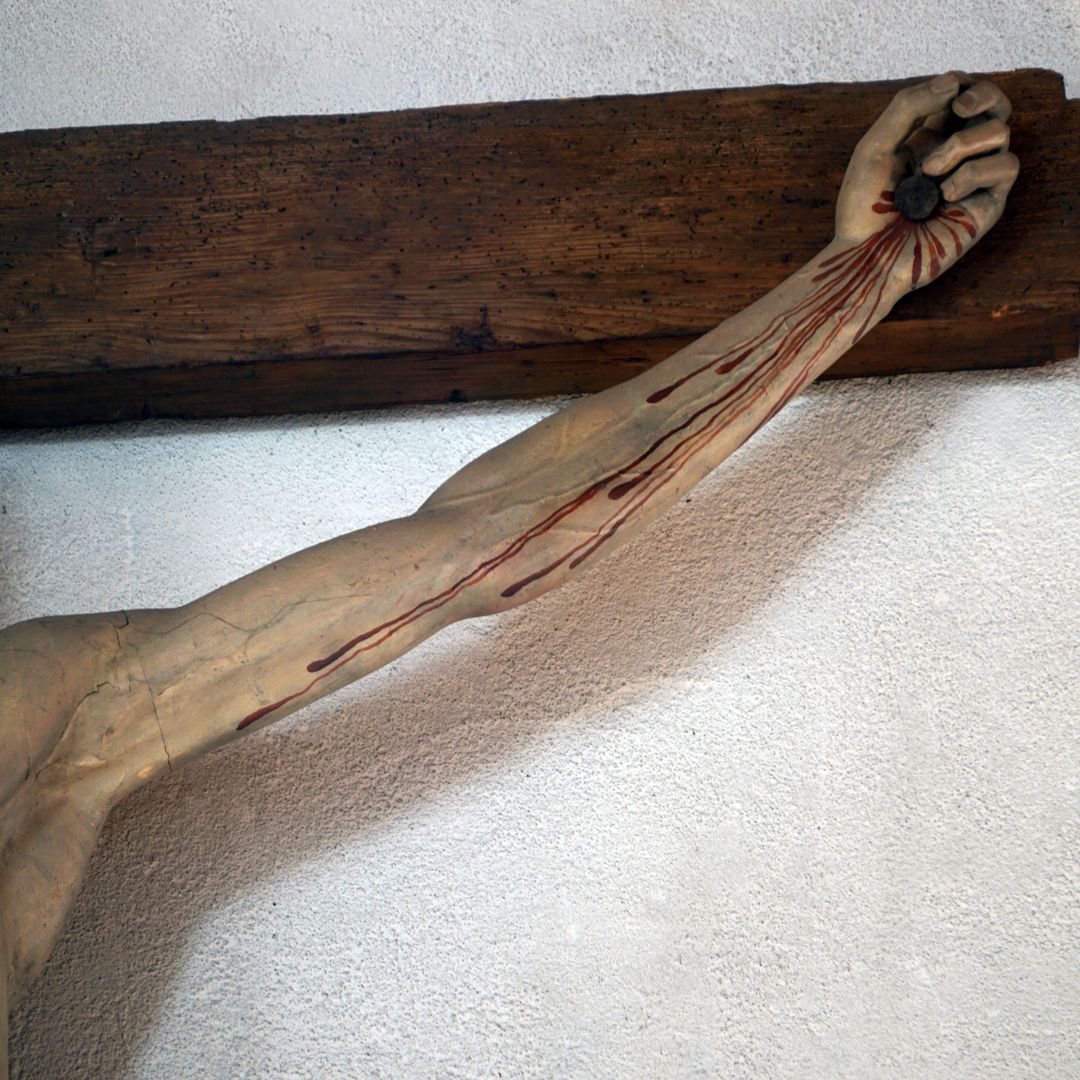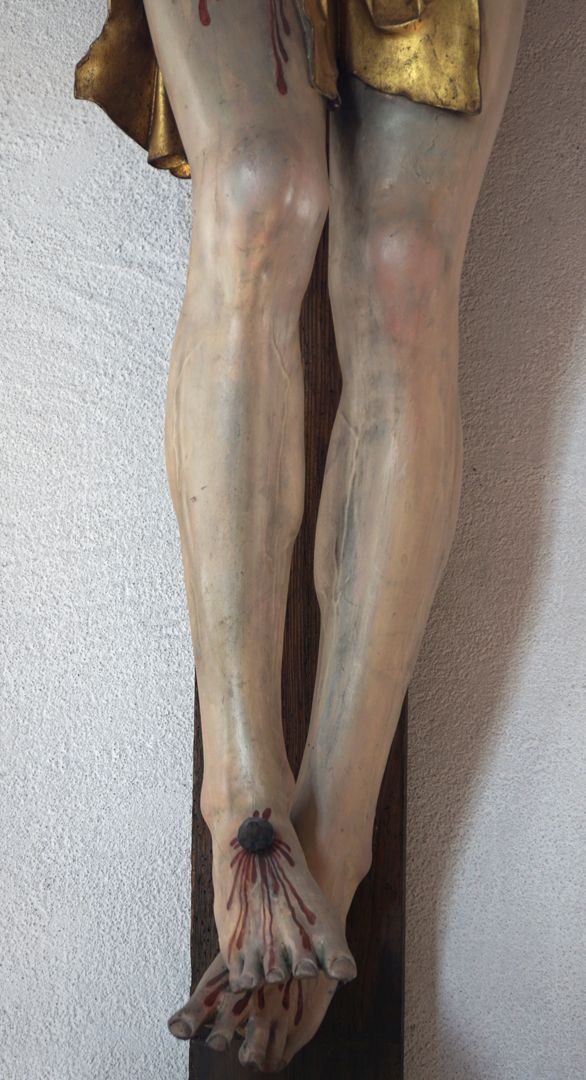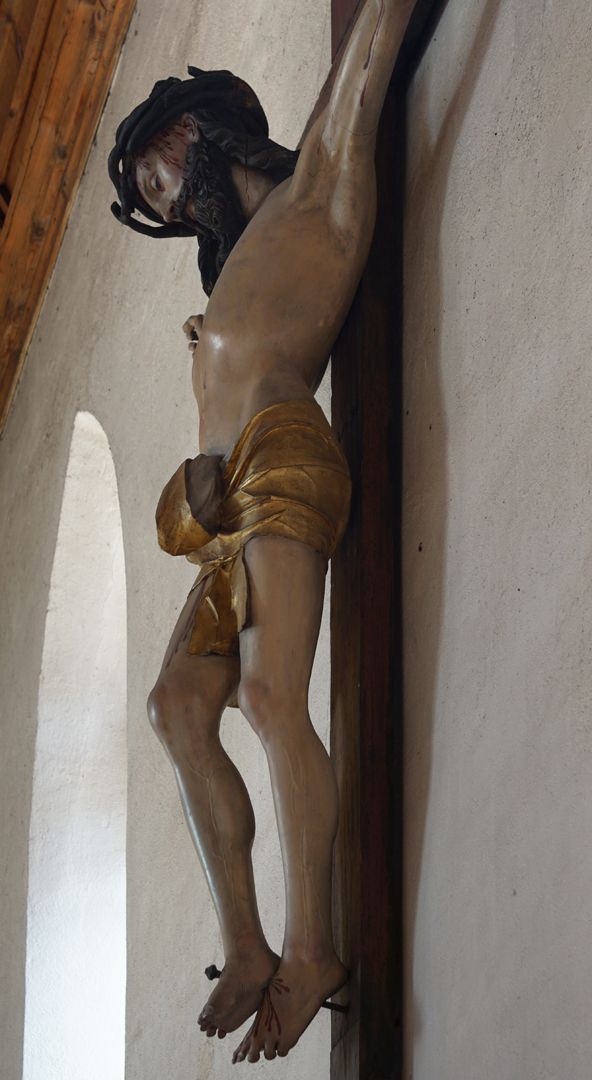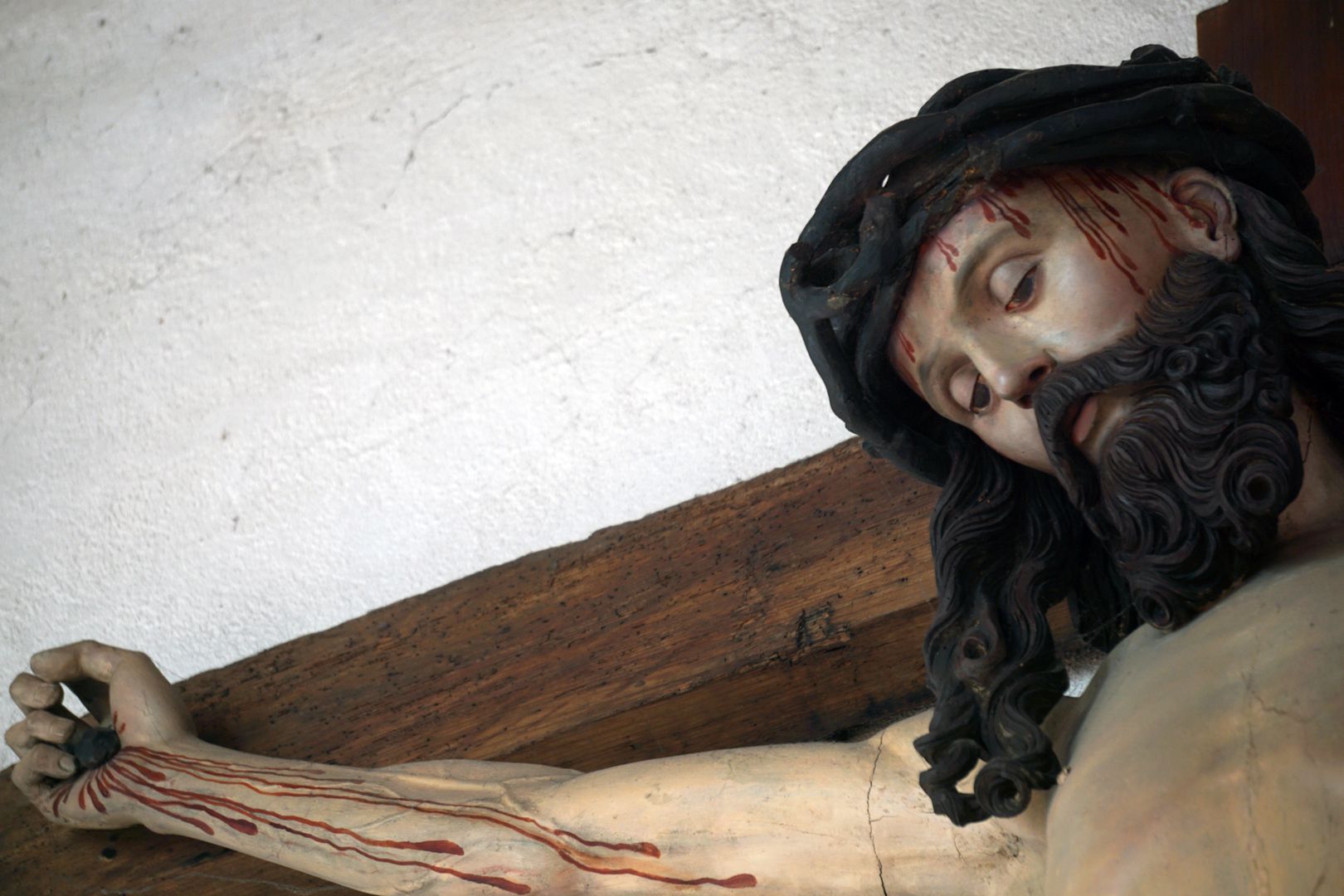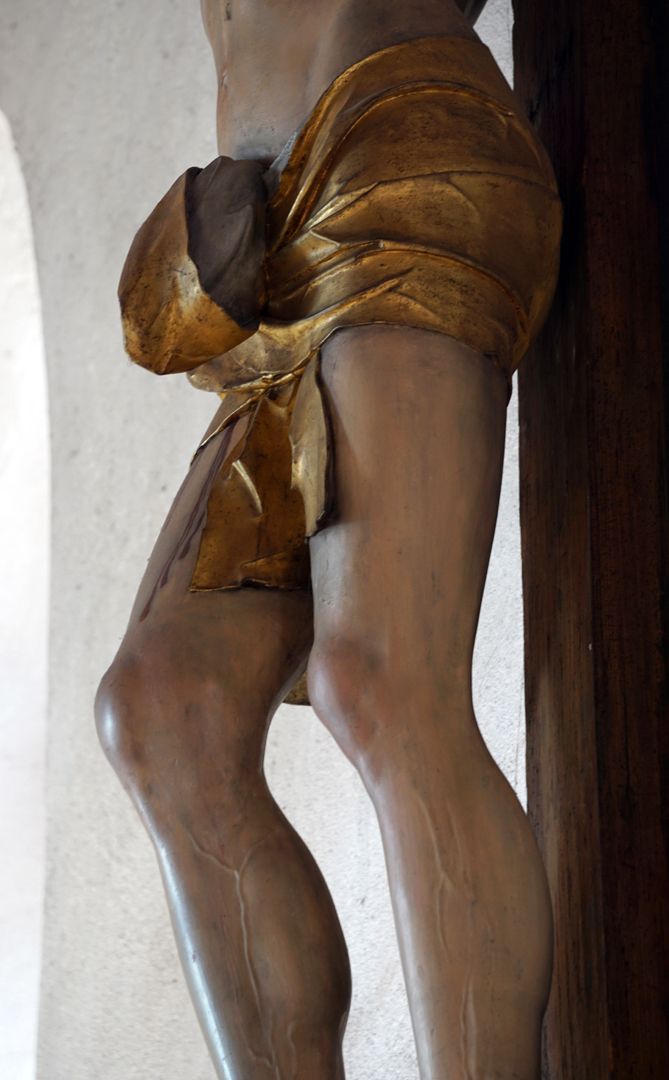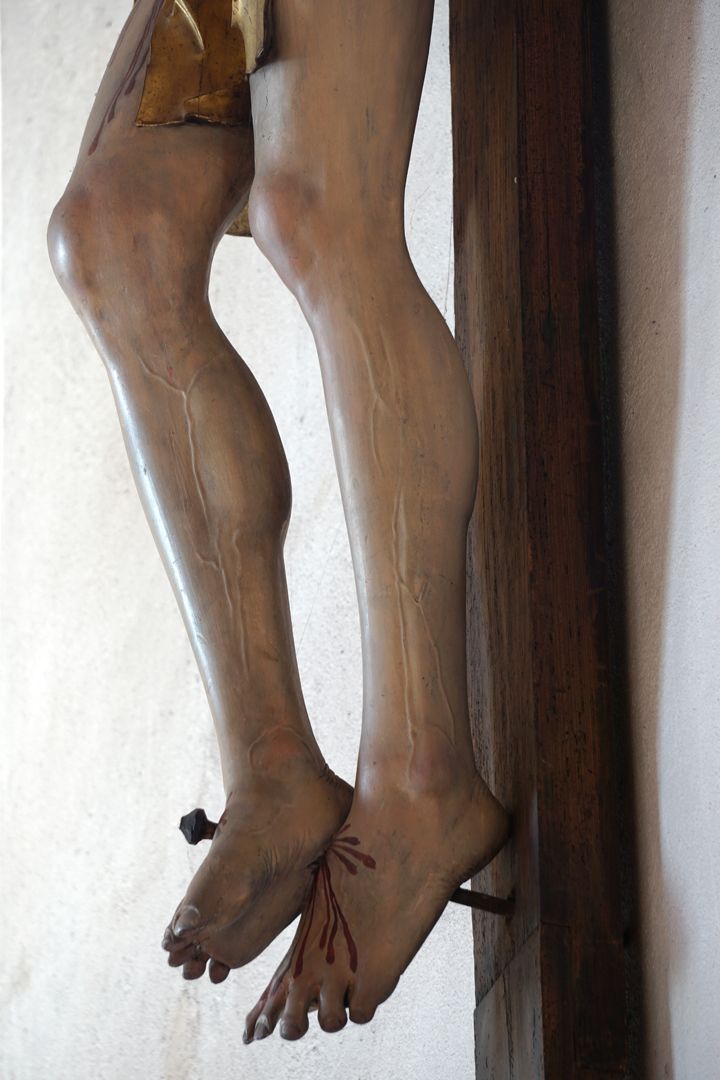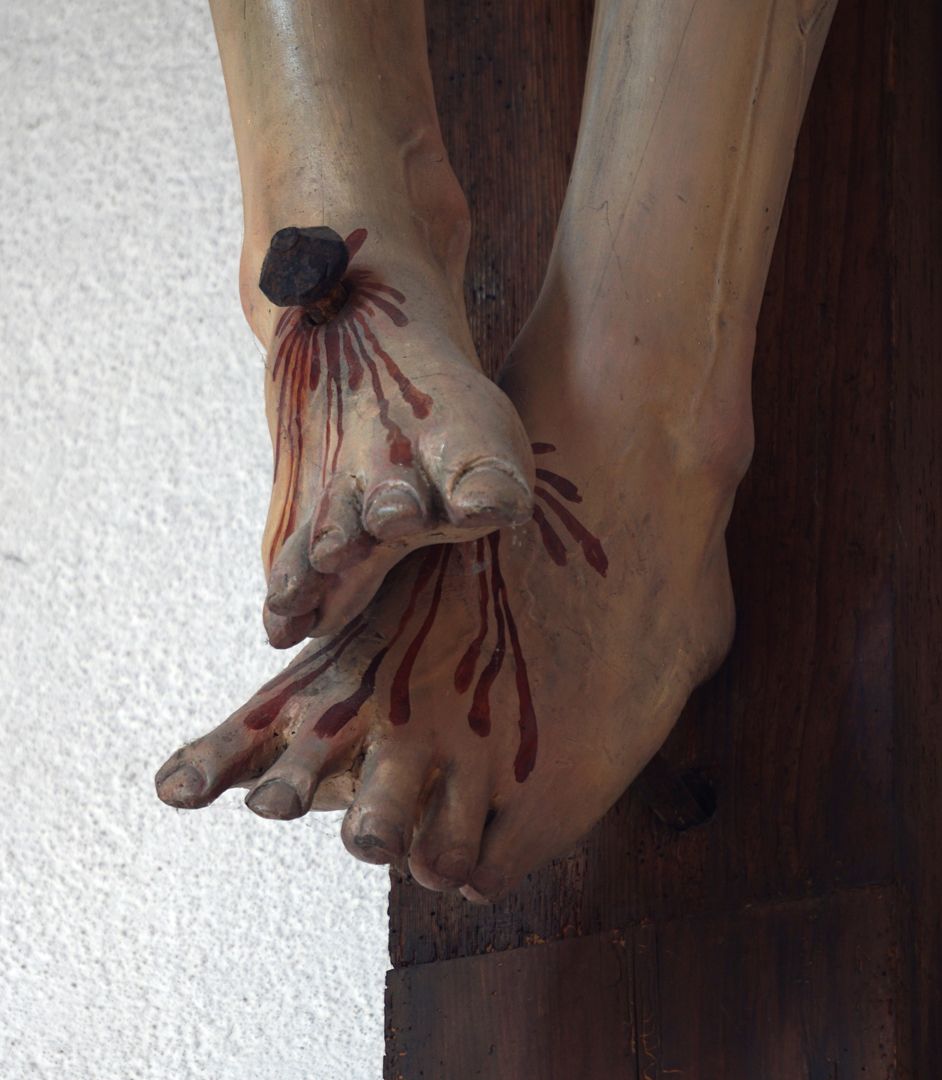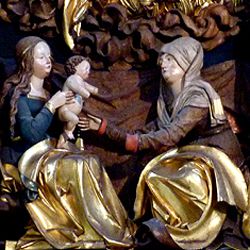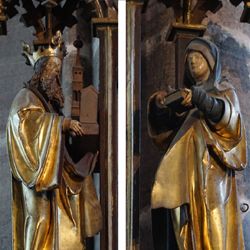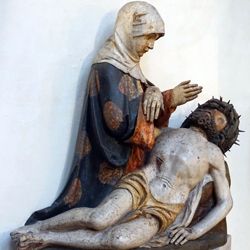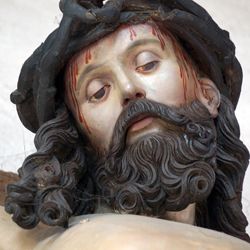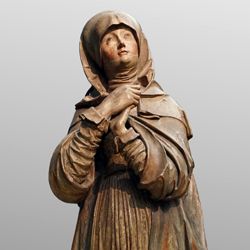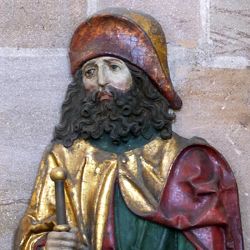Crucifix
Crucifix
around 1515
View into the church from the east
"The strong corpus, depicted in idealised beauty, hangs on the cross with its hands nailed to the crossbeahttps://www.deepl.com/pro?cta=header-pro-buttonms slightly above crown level. In contrast to the famous expressive crucifixes by Veit Stoß, this figure radiates great emotional calm. This is also expressed formally. The limbs are not painfully overstretched: the legs are only slightly bent, one above the other, and the arms are raised in a delicate curve.
The body contour runs in generous soft sweeps. The fluffy fabric of the loincloth over the crotch remains compact and does not develop a spatially moving life of its own. Only one fold over the right hip is voluminous, otherwise fine, sharply split folds define the fabric of the pubic cloth, which is pulled tightly around the loins and whose short, loose ends fall steeply down. The familiar small-wave swinging hem edges suggest slight movement of the textile. The treatment of the loincloth is involuntarily reminiscent of the design of the vestments in the Bruck Resurrection Christ or in the Nuremberg Annenschrein. The compactness of the strongly corporeal Christ's body in St. Jobst resembles the shrine figures in Bruck and Nuremberg with their bulging volumes. However, the compact proportions of the Bruck shrine figures have now been elongated into the noble, as in the Annenschrein in Lorenzen. Nevertheless, a comparative look at the heads of the Crucified and the Bruck Paul leaves no doubt about an attribution to the same carver." (Stefan Roller, Hans von Kulmbach und der Nürnberger Bildschnitzer Meister Jörg, in: Renaissance in Franken. Hans von Kulmbach and the Art around Dürer, 2022, p.117).
The original destination is not known. Stefan Roller suggests that the cross can be identified with the crucifix that stood in front of the west gallery of the Dominican Church in Nuremberg together with a Madonna below it. The Madonna is identified with the Nuremberg Madonna in the GNM, to which the crucifix from St. Jobst "with its slender silhouette of loincloth and legs fits perfectly with the slender figure of the Dolorosa, but which above all shows a much greater stylistic closeness [than the Christ in the Nuremberg Burgkapelle, which comes from the circle of Veit Stoß] and the same still-pathetic habitus". The cross in front of the west portal in the Dominican Church is
mentioned for the first time in connection with an eternal endowment by Hieronymus Haller, who died in 1519 and could thus also be a potential donor of the crucifix and Madonna. Cf. Roller, pp. 122-123.
See: Nuremberg Madonna
Location: Nuremberg, St. Jobst
Design: Herb (Meister Jörg Pildschnitzer), Georg
Realization: Herb (Meister Jörg Pildschnitzer), Georg
Material: Wood
photo 2022, Theo Noll
Crucifix
around 1515
General view, south wall
"The strong corpus, depicted in idealised beauty, hangs on the cross with its hands nailed to the crossbeahttps://www.deepl.com/pro?cta=header-pro-buttonms slightly above crown level. In contrast to the famous expressive crucifixes by Veit Stoß, this figure radiates great emotional calm. This is also expressed formally. The limbs are not painfully overstretched: the legs are only slightly bent, one above the other, and the arms are raised in a delicate curve.
The body contour runs in generous soft sweeps. The fluffy fabric of the loincloth over the crotch remains compact and does not develop a spatially moving life of its own. Only one fold over the right hip is voluminous, otherwise fine, sharply split folds define the fabric of the pubic cloth, which is pulled tightly around the loins and whose short, loose ends fall steeply down. The familiar small-wave swinging hem edges suggest slight movement of the textile. The treatment of the loincloth is involuntarily reminiscent of the design of the vestments in the Bruck Resurrection Christ or in the Nuremberg Annenschrein. The compactness of the strongly corporeal Christ's body in St. Jobst resembles the shrine figures in Bruck and Nuremberg with their bulging volumes. However, the compact proportions of the Bruck shrine figures have now been elongated into the noble, as in the Annenschrein in Lorenzen. Nevertheless, a comparative look at the heads of the Crucified and the Bruck Paul leaves no doubt about an attribution to the same carver." (Stefan Roller, Hans von Kulmbach und der Nürnberger Bildschnitzer Meister Jörg, in: Renaissance in Franken. Hans von Kulmbach and the Art around Dürer, 2022, p.117).
The original destination is not known. Stefan Roller suggests that the cross can be identified with the crucifix that stood in front of the west gallery of the Dominican Church in Nuremberg together with a Madonna below it. The Madonna is identified with the Nuremberg Madonna in the GNM, to which the crucifix from St. Jobst "with its slender silhouette of loincloth and legs fits perfectly with the slender figure of the Dolorosa, but which above all shows a much greater stylistic closeness [than the Christ in the Nuremberg Burgkapelle, which comes from the circle of Veit Stoß] and the same still-pathetic habitus". The cross in front of the west portal in the Dominican Church is
mentioned for the first time in connection with an eternal endowment by Hieronymus Haller, who died in 1519 and could thus also be a potential donor of the crucifix and Madonna. Cf. Roller, pp. 122-123.
See: Nuremberg Madonna
Location: Nuremberg, St. Jobst
Design: Herb (Meister Jörg Pildschnitzer), Georg
Realization: Herb (Meister Jörg Pildschnitzer), Georg
Material: Wood
photo 2022, Theo Noll
Crucifix
around 1515
side view
"The strong corpus, depicted in idealised beauty, hangs on the cross with its hands nailed to the crossbeahttps://www.deepl.com/pro?cta=header-pro-buttonms slightly above crown level. In contrast to the famous expressive crucifixes by Veit Stoß, this figure radiates great emotional calm. This is also expressed formally. The limbs are not painfully overstretched: the legs are only slightly bent, one above the other, and the arms are raised in a delicate curve.
The body contour runs in generous soft sweeps. The fluffy fabric of the loincloth over the crotch remains compact and does not develop a spatially moving life of its own. Only one fold over the right hip is voluminous, otherwise fine, sharply split folds define the fabric of the pubic cloth, which is pulled tightly around the loins and whose short, loose ends fall steeply down. The familiar small-wave swinging hem edges suggest slight movement of the textile. The treatment of the loincloth is involuntarily reminiscent of the design of the vestments in the Bruck Resurrection Christ or in the Nuremberg Annenschrein. The compactness of the strongly corporeal Christ's body in St. Jobst resembles the shrine figures in Bruck and Nuremberg with their bulging volumes. However, the compact proportions of the Bruck shrine figures have now been elongated into the noble, as in the Annenschrein in Lorenzen. Nevertheless, a comparative look at the heads of the Crucified and the Bruck Paul leaves no doubt about an attribution to the same carver." (Stefan Roller, Hans von Kulmbach und der Nürnberger Bildschnitzer Meister Jörg, in: Renaissance in Franken. Hans von Kulmbach and the Art around Dürer, 2022, p.117).
The original destination is not known. Stefan Roller suggests that the cross can be identified with the crucifix that stood in front of the west gallery of the Dominican Church in Nuremberg together with a Madonna below it. The Madonna is identified with the Nuremberg Madonna in the GNM, to which the crucifix from St. Jobst "with its slender silhouette of loincloth and legs fits perfectly with the slender figure of the Dolorosa, but which above all shows a much greater stylistic closeness [than the Christ in the Nuremberg Burgkapelle, which comes from the circle of Veit Stoß] and the same still-pathetic habitus". The cross in front of the west portal in the Dominican Church is
mentioned for the first time in connection with an eternal endowment by Hieronymus Haller, who died in 1519 and could thus also be a potential donor of the crucifix and Madonna. Cf. Roller, pp. 122-123.
See: Nuremberg Madonna
Location: Nuremberg, St. Jobst
Design: Herb (Meister Jörg Pildschnitzer), Georg
Realization: Herb (Meister Jörg Pildschnitzer), Georg
Material: Wood
photo 2022, Theo Noll
Crucifix
around 1515
legs, side view
"The strong corpus, depicted in idealised beauty, hangs on the cross with its hands nailed to the crossbeahttps://www.deepl.com/pro?cta=header-pro-buttonms slightly above crown level. In contrast to the famous expressive crucifixes by Veit Stoß, this figure radiates great emotional calm. This is also expressed formally. The limbs are not painfully overstretched: the legs are only slightly bent, one above the other, and the arms are raised in a delicate curve.
The body contour runs in generous soft sweeps. The fluffy fabric of the loincloth over the crotch remains compact and does not develop a spatially moving life of its own. Only one fold over the right hip is voluminous, otherwise fine, sharply split folds define the fabric of the pubic cloth, which is pulled tightly around the loins and whose short, loose ends fall steeply down. The familiar small-wave swinging hem edges suggest slight movement of the textile. The treatment of the loincloth is involuntarily reminiscent of the design of the vestments in the Bruck Resurrection Christ or in the Nuremberg Annenschrein. The compactness of the strongly corporeal Christ's body in St. Jobst resembles the shrine figures in Bruck and Nuremberg with their bulging volumes. However, the compact proportions of the Bruck shrine figures have now been elongated into the noble, as in the Annenschrein in Lorenzen. Nevertheless, a comparative look at the heads of the Crucified and the Bruck Paul leaves no doubt about an attribution to the same carver." (Stefan Roller, Hans von Kulmbach und der Nürnberger Bildschnitzer Meister Jörg, in: Renaissance in Franken. Hans von Kulmbach and the Art around Dürer, 2022, p.117).
The original destination is not known. Stefan Roller suggests that the cross can be identified with the crucifix that stood in front of the west gallery of the Dominican Church in Nuremberg together with a Madonna below it. The Madonna is identified with the Nuremberg Madonna in the GNM, to which the crucifix from St. Jobst "with its slender silhouette of loincloth and legs fits perfectly with the slender figure of the Dolorosa, but which above all shows a much greater stylistic closeness [than the Christ in the Nuremberg Burgkapelle, which comes from the circle of Veit Stoß] and the same still-pathetic habitus". The cross in front of the west portal in the Dominican Church is
mentioned for the first time in connection with an eternal endowment by Hieronymus Haller, who died in 1519 and could thus also be a potential donor of the crucifix and Madonna. Cf. Roller, pp. 122-123.
See: Nuremberg Madonna
Location: Nuremberg, St. Jobst
Design: Herb (Meister Jörg Pildschnitzer), Georg
Realization: Herb (Meister Jörg Pildschnitzer), Georg
Material: Wood
photo 2022, Theo Noll
Crucifix
around 1515
"The strong corpus, depicted in idealised beauty, hangs on the cross with its hands nailed to the crossbeahttps://www.deepl.com/pro?cta=header-pro-buttonms slightly above crown level. In contrast to the famous expressive crucifixes by Veit Stoß, this figure radiates great emotional calm. This is also expressed formally. The limbs are not painfully overstretched: the legs are only slightly bent, one above the other, and the arms are raised in a delicate curve.
The body contour runs in generous soft sweeps. The fluffy fabric of the loincloth over the crotch remains compact and does not develop a spatially moving life of its own. Only one fold over the right hip is voluminous, otherwise fine, sharply split folds define the fabric of the pubic cloth, which is pulled tightly around the loins and whose short, loose ends fall steeply down. The familiar small-wave swinging hem edges suggest slight movement of the textile. The treatment of the loincloth is involuntarily reminiscent of the design of the vestments in the Bruck Resurrection Christ or in the Nuremberg Annenschrein. The compactness of the strongly corporeal Christ's body in St. Jobst resembles the shrine figures in Bruck and Nuremberg with their bulging volumes. However, the compact proportions of the Bruck shrine figures have now been elongated into the noble, as in the Annenschrein in Lorenzen. Nevertheless, a comparative look at the heads of the Crucified and the Bruck Paul leaves no doubt about an attribution to the same carver." (Stefan Roller, Hans von Kulmbach und der Nürnberger Bildschnitzer Meister Jörg, in: Renaissance in Franken. Hans von Kulmbach and the Art around Dürer, 2022, p.117).
The original destination is not known. Stefan Roller suggests that the cross can be identified with the crucifix that stood in front of the west gallery of the Dominican Church in Nuremberg together with a Madonna below it. The Madonna is identified with the Nuremberg Madonna in the GNM, to which the crucifix from St. Jobst "with its slender silhouette of loincloth and legs fits perfectly with the slender figure of the Dolorosa, but which above all shows a much greater stylistic closeness [than the Christ in the Nuremberg Burgkapelle, which comes from the circle of Veit Stoß] and the same still-pathetic habitus". The cross in front of the west portal in the Dominican Church is
mentioned for the first time in connection with an eternal endowment by Hieronymus Haller, who died in 1519 and could thus also be a potential donor of the crucifix and Madonna. Cf. Roller, pp. 122-123.
See: Nuremberg Madonna
Location: Nuremberg, St. Jobst
Design: Herb (Meister Jörg Pildschnitzer), Georg
Realization: Herb (Meister Jörg Pildschnitzer), Georg
Material: Wood
photo 2022, Theo Noll
Crucifix
around 1515
Head, view from the front
"The strong corpus, depicted in idealised beauty, hangs on the cross with its hands nailed to the crossbeahttps://www.deepl.com/pro?cta=header-pro-buttonms slightly above crown level. In contrast to the famous expressive crucifixes by Veit Stoß, this figure radiates great emotional calm. This is also expressed formally. The limbs are not painfully overstretched: the legs are only slightly bent, one above the other, and the arms are raised in a delicate curve.
The body contour runs in generous soft sweeps. The fluffy fabric of the loincloth over the crotch remains compact and does not develop a spatially moving life of its own. Only one fold over the right hip is voluminous, otherwise fine, sharply split folds define the fabric of the pubic cloth, which is pulled tightly around the loins and whose short, loose ends fall steeply down. The familiar small-wave swinging hem edges suggest slight movement of the textile. The treatment of the loincloth is involuntarily reminiscent of the design of the vestments in the Bruck Resurrection Christ or in the Nuremberg Annenschrein. The compactness of the strongly corporeal Christ's body in St. Jobst resembles the shrine figures in Bruck and Nuremberg with their bulging volumes. However, the compact proportions of the Bruck shrine figures have now been elongated into the noble, as in the Annenschrein in Lorenzen. Nevertheless, a comparative look at the heads of the Crucified and the Bruck Paul leaves no doubt about an attribution to the same carver." (Stefan Roller, Hans von Kulmbach und der Nürnberger Bildschnitzer Meister Jörg, in: Renaissance in Franken. Hans von Kulmbach and the Art around Dürer, 2022, p.117).
The original destination is not known. Stefan Roller suggests that the cross can be identified with the crucifix that stood in front of the west gallery of the Dominican Church in Nuremberg together with a Madonna below it. The Madonna is identified with the Nuremberg Madonna in the GNM, to which the crucifix from St. Jobst "with its slender silhouette of loincloth and legs fits perfectly with the slender figure of the Dolorosa, but which above all shows a much greater stylistic closeness [than the Christ in the Nuremberg Burgkapelle, which comes from the circle of Veit Stoß] and the same still-pathetic habitus". The cross in front of the west portal in the Dominican Church is
mentioned for the first time in connection with an eternal endowment by Hieronymus Haller, who died in 1519 and could thus also be a potential donor of the crucifix and Madonna. Cf. Roller, pp. 122-123.
See: Nuremberg Madonna
Location: Nuremberg, St. Jobst
Design: Herb (Meister Jörg Pildschnitzer), Georg
Realization: Herb (Meister Jörg Pildschnitzer), Georg
Material: Wood
photo 2022, Theo Noll
Crucifix
around 1515
Front view
"The strong corpus, depicted in idealised beauty, hangs on the cross with its hands nailed to the crossbeahttps://www.deepl.com/pro?cta=header-pro-buttonms slightly above crown level. In contrast to the famous expressive crucifixes by Veit Stoß, this figure radiates great emotional calm. This is also expressed formally. The limbs are not painfully overstretched: the legs are only slightly bent, one above the other, and the arms are raised in a delicate curve.
The body contour runs in generous soft sweeps. The fluffy fabric of the loincloth over the crotch remains compact and does not develop a spatially moving life of its own. Only one fold over the right hip is voluminous, otherwise fine, sharply split folds define the fabric of the pubic cloth, which is pulled tightly around the loins and whose short, loose ends fall steeply down. The familiar small-wave swinging hem edges suggest slight movement of the textile. The treatment of the loincloth is involuntarily reminiscent of the design of the vestments in the Bruck Resurrection Christ or in the Nuremberg Annenschrein. The compactness of the strongly corporeal Christ's body in St. Jobst resembles the shrine figures in Bruck and Nuremberg with their bulging volumes. However, the compact proportions of the Bruck shrine figures have now been elongated into the noble, as in the Annenschrein in Lorenzen. Nevertheless, a comparative look at the heads of the Crucified and the Bruck Paul leaves no doubt about an attribution to the same carver." (Stefan Roller, Hans von Kulmbach und der Nürnberger Bildschnitzer Meister Jörg, in: Renaissance in Franken. Hans von Kulmbach and the Art around Dürer, 2022, p.117).
The original destination is not known. Stefan Roller suggests that the cross can be identified with the crucifix that stood in front of the west gallery of the Dominican Church in Nuremberg together with a Madonna below it. The Madonna is identified with the Nuremberg Madonna in the GNM, to which the crucifix from St. Jobst "with its slender silhouette of loincloth and legs fits perfectly with the slender figure of the Dolorosa, but which above all shows a much greater stylistic closeness [than the Christ in the Nuremberg Burgkapelle, which comes from the circle of Veit Stoß] and the same still-pathetic habitus". The cross in front of the west portal in the Dominican Church is
mentioned for the first time in connection with an eternal endowment by Hieronymus Haller, who died in 1519 and could thus also be a potential donor of the crucifix and Madonna. Cf. Roller, pp. 122-123.
See: Nuremberg Madonna
Location: Nuremberg, St. Jobst
Design: Herb (Meister Jörg Pildschnitzer), Georg
Realization: Herb (Meister Jörg Pildschnitzer), Georg
Material: Wood
photo 2022, Theo Noll
Crucifix
around 1515
Detailed view of the left arm
"The strong corpus, depicted in idealised beauty, hangs on the cross with its hands nailed to the crossbeahttps://www.deepl.com/pro?cta=header-pro-buttonms slightly above crown level. In contrast to the famous expressive crucifixes by Veit Stoß, this figure radiates great emotional calm. This is also expressed formally. The limbs are not painfully overstretched: the legs are only slightly bent, one above the other, and the arms are raised in a delicate curve.
The body contour runs in generous soft sweeps. The fluffy fabric of the loincloth over the crotch remains compact and does not develop a spatially moving life of its own. Only one fold over the right hip is voluminous, otherwise fine, sharply split folds define the fabric of the pubic cloth, which is pulled tightly around the loins and whose short, loose ends fall steeply down. The familiar small-wave swinging hem edges suggest slight movement of the textile. The treatment of the loincloth is involuntarily reminiscent of the design of the vestments in the Bruck Resurrection Christ or in the Nuremberg Annenschrein. The compactness of the strongly corporeal Christ's body in St. Jobst resembles the shrine figures in Bruck and Nuremberg with their bulging volumes. However, the compact proportions of the Bruck shrine figures have now been elongated into the noble, as in the Annenschrein in Lorenzen. Nevertheless, a comparative look at the heads of the Crucified and the Bruck Paul leaves no doubt about an attribution to the same carver." (Stefan Roller, Hans von Kulmbach und der Nürnberger Bildschnitzer Meister Jörg, in: Renaissance in Franken. Hans von Kulmbach and the Art around Dürer, 2022, p.117).
The original destination is not known. Stefan Roller suggests that the cross can be identified with the crucifix that stood in front of the west gallery of the Dominican Church in Nuremberg together with a Madonna below it. The Madonna is identified with the Nuremberg Madonna in the GNM, to which the crucifix from St. Jobst "with its slender silhouette of loincloth and legs fits perfectly with the slender figure of the Dolorosa, but which above all shows a much greater stylistic closeness [than the Christ in the Nuremberg Burgkapelle, which comes from the circle of Veit Stoß] and the same still-pathetic habitus". The cross in front of the west portal in the Dominican Church is
mentioned for the first time in connection with an eternal endowment by Hieronymus Haller, who died in 1519 and could thus also be a potential donor of the crucifix and Madonna. Cf. Roller, pp. 122-123.
See: Nuremberg Madonna
Location: Nuremberg, St. Jobst
Design: Herb (Meister Jörg Pildschnitzer), Georg
Realization: Herb (Meister Jörg Pildschnitzer), Georg
Material: Wood
photo 2022, Theo Noll
Crucifix
around 1515
Detailed view
"The strong corpus, depicted in idealised beauty, hangs on the cross with its hands nailed to the crossbeahttps://www.deepl.com/pro?cta=header-pro-buttonms slightly above crown level. In contrast to the famous expressive crucifixes by Veit Stoß, this figure radiates great emotional calm. This is also expressed formally. The limbs are not painfully overstretched: the legs are only slightly bent, one above the other, and the arms are raised in a delicate curve.
The body contour runs in generous soft sweeps. The fluffy fabric of the loincloth over the crotch remains compact and does not develop a spatially moving life of its own. Only one fold over the right hip is voluminous, otherwise fine, sharply split folds define the fabric of the pubic cloth, which is pulled tightly around the loins and whose short, loose ends fall steeply down. The familiar small-wave swinging hem edges suggest slight movement of the textile. The treatment of the loincloth is involuntarily reminiscent of the design of the vestments in the Bruck Resurrection Christ or in the Nuremberg Annenschrein. The compactness of the strongly corporeal Christ's body in St. Jobst resembles the shrine figures in Bruck and Nuremberg with their bulging volumes. However, the compact proportions of the Bruck shrine figures have now been elongated into the noble, as in the Annenschrein in Lorenzen. Nevertheless, a comparative look at the heads of the Crucified and the Bruck Paul leaves no doubt about an attribution to the same carver." (Stefan Roller, Hans von Kulmbach und der Nürnberger Bildschnitzer Meister Jörg, in: Renaissance in Franken. Hans von Kulmbach and the Art around Dürer, 2022, p.117).
The original destination is not known. Stefan Roller suggests that the cross can be identified with the crucifix that stood in front of the west gallery of the Dominican Church in Nuremberg together with a Madonna below it. The Madonna is identified with the Nuremberg Madonna in the GNM, to which the crucifix from St. Jobst "with its slender silhouette of loincloth and legs fits perfectly with the slender figure of the Dolorosa, but which above all shows a much greater stylistic closeness [than the Christ in the Nuremberg Burgkapelle, which comes from the circle of Veit Stoß] and the same still-pathetic habitus". The cross in front of the west portal in the Dominican Church is
mentioned for the first time in connection with an eternal endowment by Hieronymus Haller, who died in 1519 and could thus also be a potential donor of the crucifix and Madonna. Cf. Roller, pp. 122-123.
See: Nuremberg Madonna
Location: Nuremberg, St. Jobst
Design: Herb (Meister Jörg Pildschnitzer), Georg
Realization: Herb (Meister Jörg Pildschnitzer), Georg
Material: Wood
photo 2022, Theo Noll
Crucifix
around 1515
Detailed view
"The strong corpus, depicted in idealised beauty, hangs on the cross with its hands nailed to the crossbeahttps://www.deepl.com/pro?cta=header-pro-buttonms slightly above crown level. In contrast to the famous expressive crucifixes by Veit Stoß, this figure radiates great emotional calm. This is also expressed formally. The limbs are not painfully overstretched: the legs are only slightly bent, one above the other, and the arms are raised in a delicate curve.
The body contour runs in generous soft sweeps. The fluffy fabric of the loincloth over the crotch remains compact and does not develop a spatially moving life of its own. Only one fold over the right hip is voluminous, otherwise fine, sharply split folds define the fabric of the pubic cloth, which is pulled tightly around the loins and whose short, loose ends fall steeply down. The familiar small-wave swinging hem edges suggest slight movement of the textile. The treatment of the loincloth is involuntarily reminiscent of the design of the vestments in the Bruck Resurrection Christ or in the Nuremberg Annenschrein. The compactness of the strongly corporeal Christ's body in St. Jobst resembles the shrine figures in Bruck and Nuremberg with their bulging volumes. However, the compact proportions of the Bruck shrine figures have now been elongated into the noble, as in the Annenschrein in Lorenzen. Nevertheless, a comparative look at the heads of the Crucified and the Bruck Paul leaves no doubt about an attribution to the same carver." (Stefan Roller, Hans von Kulmbach und der Nürnberger Bildschnitzer Meister Jörg, in: Renaissance in Franken. Hans von Kulmbach and the Art around Dürer, 2022, p.117).
The original destination is not known. Stefan Roller suggests that the cross can be identified with the crucifix that stood in front of the west gallery of the Dominican Church in Nuremberg together with a Madonna below it. The Madonna is identified with the Nuremberg Madonna in the GNM, to which the crucifix from St. Jobst "with its slender silhouette of loincloth and legs fits perfectly with the slender figure of the Dolorosa, but which above all shows a much greater stylistic closeness [than the Christ in the Nuremberg Burgkapelle, which comes from the circle of Veit Stoß] and the same still-pathetic habitus". The cross in front of the west portal in the Dominican Church is
mentioned for the first time in connection with an eternal endowment by Hieronymus Haller, who died in 1519 and could thus also be a potential donor of the crucifix and Madonna. Cf. Roller, pp. 122-123.
See: Nuremberg Madonna
Location: Nuremberg, St. Jobst
Design: Herb (Meister Jörg Pildschnitzer), Georg
Realization: Herb (Meister Jörg Pildschnitzer), Georg
Material: Wood
photo 2022, Theo Noll
Crucifix
around 1515
Detailed view (flashlight)
"The strong corpus, depicted in idealised beauty, hangs on the cross with its hands nailed to the crossbeahttps://www.deepl.com/pro?cta=header-pro-buttonms slightly above crown level. In contrast to the famous expressive crucifixes by Veit Stoß, this figure radiates great emotional calm. This is also expressed formally. The limbs are not painfully overstretched: the legs are only slightly bent, one above the other, and the arms are raised in a delicate curve.
The body contour runs in generous soft sweeps. The fluffy fabric of the loincloth over the crotch remains compact and does not develop a spatially moving life of its own. Only one fold over the right hip is voluminous, otherwise fine, sharply split folds define the fabric of the pubic cloth, which is pulled tightly around the loins and whose short, loose ends fall steeply down. The familiar small-wave swinging hem edges suggest slight movement of the textile. The treatment of the loincloth is involuntarily reminiscent of the design of the vestments in the Bruck Resurrection Christ or in the Nuremberg Annenschrein. The compactness of the strongly corporeal Christ's body in St. Jobst resembles the shrine figures in Bruck and Nuremberg with their bulging volumes. However, the compact proportions of the Bruck shrine figures have now been elongated into the noble, as in the Annenschrein in Lorenzen. Nevertheless, a comparative look at the heads of the Crucified and the Bruck Paul leaves no doubt about an attribution to the same carver." (Stefan Roller, Hans von Kulmbach und der Nürnberger Bildschnitzer Meister Jörg, in: Renaissance in Franken. Hans von Kulmbach and the Art around Dürer, 2022, p.117).
The original destination is not known. Stefan Roller suggests that the cross can be identified with the crucifix that stood in front of the west gallery of the Dominican Church in Nuremberg together with a Madonna below it. The Madonna is identified with the Nuremberg Madonna in the GNM, to which the crucifix from St. Jobst "with its slender silhouette of loincloth and legs fits perfectly with the slender figure of the Dolorosa, but which above all shows a much greater stylistic closeness [than the Christ in the Nuremberg Burgkapelle, which comes from the circle of Veit Stoß] and the same still-pathetic habitus". The cross in front of the west portal in the Dominican Church is
mentioned for the first time in connection with an eternal endowment by Hieronymus Haller, who died in 1519 and could thus also be a potential donor of the crucifix and Madonna. Cf. Roller, pp. 122-123.
See: Nuremberg Madonna
Location: Nuremberg, St. Jobst
Design: Herb (Meister Jörg Pildschnitzer), Georg
Realization: Herb (Meister Jörg Pildschnitzer), Georg
Material: Wood
photo 2022, Theo Noll
Crucifix
around 1515
Loincloth with the "small-wave swinging hem edges"
"The strong corpus, depicted in idealised beauty, hangs on the cross with its hands nailed to the crossbeahttps://www.deepl.com/pro?cta=header-pro-buttonms slightly above crown level. In contrast to the famous expressive crucifixes by Veit Stoß, this figure radiates great emotional calm. This is also expressed formally. The limbs are not painfully overstretched: the legs are only slightly bent, one above the other, and the arms are raised in a delicate curve.
The body contour runs in generous soft sweeps. The fluffy fabric of the loincloth over the crotch remains compact and does not develop a spatially moving life of its own. Only one fold over the right hip is voluminous, otherwise fine, sharply split folds define the fabric of the pubic cloth, which is pulled tightly around the loins and whose short, loose ends fall steeply down. The familiar small-wave swinging hem edges suggest slight movement of the textile. The treatment of the loincloth is involuntarily reminiscent of the design of the vestments in the Bruck Resurrection Christ or in the Nuremberg Annenschrein. The compactness of the strongly corporeal Christ's body in St. Jobst resembles the shrine figures in Bruck and Nuremberg with their bulging volumes. However, the compact proportions of the Bruck shrine figures have now been elongated into the noble, as in the Annenschrein in Lorenzen. Nevertheless, a comparative look at the heads of the Crucified and the Bruck Paul leaves no doubt about an attribution to the same carver." (Stefan Roller, Hans von Kulmbach und der Nürnberger Bildschnitzer Meister Jörg, in: Renaissance in Franken. Hans von Kulmbach and the Art around Dürer, 2022, p.117).
The original destination is not known. Stefan Roller suggests that the cross can be identified with the crucifix that stood in front of the west gallery of the Dominican Church in Nuremberg together with a Madonna below it. The Madonna is identified with the Nuremberg Madonna in the GNM, to which the crucifix from St. Jobst "with its slender silhouette of loincloth and legs fits perfectly with the slender figure of the Dolorosa, but which above all shows a much greater stylistic closeness [than the Christ in the Nuremberg Burgkapelle, which comes from the circle of Veit Stoß] and the same still-pathetic habitus". The cross in front of the west portal in the Dominican Church is
mentioned for the first time in connection with an eternal endowment by Hieronymus Haller, who died in 1519 and could thus also be a potential donor of the crucifix and Madonna. Cf. Roller, pp. 122-123.
See: Nuremberg Madonna
Location: Nuremberg, St. Jobst
Design: Herb (Meister Jörg Pildschnitzer), Georg
Realization: Herb (Meister Jörg Pildschnitzer), Georg
Material: Wood
photo 2022, Theo Noll
Crucifix
around 1515
Loincloth with the "small-wave swinging hem edges", side view
"The strong corpus, depicted in idealised beauty, hangs on the cross with its hands nailed to the crossbeahttps://www.deepl.com/pro?cta=header-pro-buttonms slightly above crown level. In contrast to the famous expressive crucifixes by Veit Stoß, this figure radiates great emotional calm. This is also expressed formally. The limbs are not painfully overstretched: the legs are only slightly bent, one above the other, and the arms are raised in a delicate curve.
The body contour runs in generous soft sweeps. The fluffy fabric of the loincloth over the crotch remains compact and does not develop a spatially moving life of its own. Only one fold over the right hip is voluminous, otherwise fine, sharply split folds define the fabric of the pubic cloth, which is pulled tightly around the loins and whose short, loose ends fall steeply down. The familiar small-wave swinging hem edges suggest slight movement of the textile. The treatment of the loincloth is involuntarily reminiscent of the design of the vestments in the Bruck Resurrection Christ or in the Nuremberg Annenschrein. The compactness of the strongly corporeal Christ's body in St. Jobst resembles the shrine figures in Bruck and Nuremberg with their bulging volumes. However, the compact proportions of the Bruck shrine figures have now been elongated into the noble, as in the Annenschrein in Lorenzen. Nevertheless, a comparative look at the heads of the Crucified and the Bruck Paul leaves no doubt about an attribution to the same carver." (Stefan Roller, Hans von Kulmbach und der Nürnberger Bildschnitzer Meister Jörg, in: Renaissance in Franken. Hans von Kulmbach and the Art around Dürer, 2022, p.117).
The original destination is not known. Stefan Roller suggests that the cross can be identified with the crucifix that stood in front of the west gallery of the Dominican Church in Nuremberg together with a Madonna below it. The Madonna is identified with the Nuremberg Madonna in the GNM, to which the crucifix from St. Jobst "with its slender silhouette of loincloth and legs fits perfectly with the slender figure of the Dolorosa, but which above all shows a much greater stylistic closeness [than the Christ in the Nuremberg Burgkapelle, which comes from the circle of Veit Stoß] and the same still-pathetic habitus". The cross in front of the west portal in the Dominican Church is
mentioned for the first time in connection with an eternal endowment by Hieronymus Haller, who died in 1519 and could thus also be a potential donor of the crucifix and Madonna. Cf. Roller, pp. 122-123.
See: Nuremberg Madonna
Location: Nuremberg, St. Jobst
Design: Herb (Meister Jörg Pildschnitzer), Georg
Realization: Herb (Meister Jörg Pildschnitzer), Georg
Material: Wood
photo 2022, Theo Noll
Crucifix
around 1515
Detailed view of the right arm
"The strong corpus, depicted in idealised beauty, hangs on the cross with its hands nailed to the crossbeahttps://www.deepl.com/pro?cta=header-pro-buttonms slightly above crown level. In contrast to the famous expressive crucifixes by Veit Stoß, this figure radiates great emotional calm. This is also expressed formally. The limbs are not painfully overstretched: the legs are only slightly bent, one above the other, and the arms are raised in a delicate curve.
The body contour runs in generous soft sweeps. The fluffy fabric of the loincloth over the crotch remains compact and does not develop a spatially moving life of its own. Only one fold over the right hip is voluminous, otherwise fine, sharply split folds define the fabric of the pubic cloth, which is pulled tightly around the loins and whose short, loose ends fall steeply down. The familiar small-wave swinging hem edges suggest slight movement of the textile. The treatment of the loincloth is involuntarily reminiscent of the design of the vestments in the Bruck Resurrection Christ or in the Nuremberg Annenschrein. The compactness of the strongly corporeal Christ's body in St. Jobst resembles the shrine figures in Bruck and Nuremberg with their bulging volumes. However, the compact proportions of the Bruck shrine figures have now been elongated into the noble, as in the Annenschrein in Lorenzen. Nevertheless, a comparative look at the heads of the Crucified and the Bruck Paul leaves no doubt about an attribution to the same carver." (Stefan Roller, Hans von Kulmbach und der Nürnberger Bildschnitzer Meister Jörg, in: Renaissance in Franken. Hans von Kulmbach and the Art around Dürer, 2022, p.117).
The original destination is not known. Stefan Roller suggests that the cross can be identified with the crucifix that stood in front of the west gallery of the Dominican Church in Nuremberg together with a Madonna below it. The Madonna is identified with the Nuremberg Madonna in the GNM, to which the crucifix from St. Jobst "with its slender silhouette of loincloth and legs fits perfectly with the slender figure of the Dolorosa, but which above all shows a much greater stylistic closeness [than the Christ in the Nuremberg Burgkapelle, which comes from the circle of Veit Stoß] and the same still-pathetic habitus". The cross in front of the west portal in the Dominican Church is
mentioned for the first time in connection with an eternal endowment by Hieronymus Haller, who died in 1519 and could thus also be a potential donor of the crucifix and Madonna. Cf. Roller, pp. 122-123.
See: Nuremberg Madonna
Location: Nuremberg, St. Jobst
Design: Herb (Meister Jörg Pildschnitzer), Georg
Realization: Herb (Meister Jörg Pildschnitzer), Georg
Material: Wood
photo 2022, Theo Noll
Crucifix
around 1515
Detailed view of the legs
"The strong corpus, depicted in idealised beauty, hangs on the cross with its hands nailed to the crossbeahttps://www.deepl.com/pro?cta=header-pro-buttonms slightly above crown level. In contrast to the famous expressive crucifixes by Veit Stoß, this figure radiates great emotional calm. This is also expressed formally. The limbs are not painfully overstretched: the legs are only slightly bent, one above the other, and the arms are raised in a delicate curve.
The body contour runs in generous soft sweeps. The fluffy fabric of the loincloth over the crotch remains compact and does not develop a spatially moving life of its own. Only one fold over the right hip is voluminous, otherwise fine, sharply split folds define the fabric of the pubic cloth, which is pulled tightly around the loins and whose short, loose ends fall steeply down. The familiar small-wave swinging hem edges suggest slight movement of the textile. The treatment of the loincloth is involuntarily reminiscent of the design of the vestments in the Bruck Resurrection Christ or in the Nuremberg Annenschrein. The compactness of the strongly corporeal Christ's body in St. Jobst resembles the shrine figures in Bruck and Nuremberg with their bulging volumes. However, the compact proportions of the Bruck shrine figures have now been elongated into the noble, as in the Annenschrein in Lorenzen. Nevertheless, a comparative look at the heads of the Crucified and the Bruck Paul leaves no doubt about an attribution to the same carver." (Stefan Roller, Hans von Kulmbach und der Nürnberger Bildschnitzer Meister Jörg, in: Renaissance in Franken. Hans von Kulmbach and the Art around Dürer, 2022, p.117).
The original destination is not known. Stefan Roller suggests that the cross can be identified with the crucifix that stood in front of the west gallery of the Dominican Church in Nuremberg together with a Madonna below it. The Madonna is identified with the Nuremberg Madonna in the GNM, to which the crucifix from St. Jobst "with its slender silhouette of loincloth and legs fits perfectly with the slender figure of the Dolorosa, but which above all shows a much greater stylistic closeness [than the Christ in the Nuremberg Burgkapelle, which comes from the circle of Veit Stoß] and the same still-pathetic habitus". The cross in front of the west portal in the Dominican Church is
mentioned for the first time in connection with an eternal endowment by Hieronymus Haller, who died in 1519 and could thus also be a potential donor of the crucifix and Madonna. Cf. Roller, pp. 122-123.
See: Nuremberg Madonna
Location: Nuremberg, St. Jobst
Design: Herb (Meister Jörg Pildschnitzer), Georg
Realization: Herb (Meister Jörg Pildschnitzer), Georg
Material: Wood
photo 2022, Theo Noll
Crucifix
around 1515
Oblique view from the west
"The strong corpus, depicted in idealised beauty, hangs on the cross with its hands nailed to the crossbeahttps://www.deepl.com/pro?cta=header-pro-buttonms slightly above crown level. In contrast to the famous expressive crucifixes by Veit Stoß, this figure radiates great emotional calm. This is also expressed formally. The limbs are not painfully overstretched: the legs are only slightly bent, one above the other, and the arms are raised in a delicate curve.
The body contour runs in generous soft sweeps. The fluffy fabric of the loincloth over the crotch remains compact and does not develop a spatially moving life of its own. Only one fold over the right hip is voluminous, otherwise fine, sharply split folds define the fabric of the pubic cloth, which is pulled tightly around the loins and whose short, loose ends fall steeply down. The familiar small-wave swinging hem edges suggest slight movement of the textile. The treatment of the loincloth is involuntarily reminiscent of the design of the vestments in the Bruck Resurrection Christ or in the Nuremberg Annenschrein. The compactness of the strongly corporeal Christ's body in St. Jobst resembles the shrine figures in Bruck and Nuremberg with their bulging volumes. However, the compact proportions of the Bruck shrine figures have now been elongated into the noble, as in the Annenschrein in Lorenzen. Nevertheless, a comparative look at the heads of the Crucified and the Bruck Paul leaves no doubt about an attribution to the same carver." (Stefan Roller, Hans von Kulmbach und der Nürnberger Bildschnitzer Meister Jörg, in: Renaissance in Franken. Hans von Kulmbach and the Art around Dürer, 2022, p.117).
The original destination is not known. Stefan Roller suggests that the cross can be identified with the crucifix that stood in front of the west gallery of the Dominican Church in Nuremberg together with a Madonna below it. The Madonna is identified with the Nuremberg Madonna in the GNM, to which the crucifix from St. Jobst "with its slender silhouette of loincloth and legs fits perfectly with the slender figure of the Dolorosa, but which above all shows a much greater stylistic closeness [than the Christ in the Nuremberg Burgkapelle, which comes from the circle of Veit Stoß] and the same still-pathetic habitus". The cross in front of the west portal in the Dominican Church is
mentioned for the first time in connection with an eternal endowment by Hieronymus Haller, who died in 1519 and could thus also be a potential donor of the crucifix and Madonna. Cf. Roller, pp. 122-123.
See: Nuremberg Madonna
Location: Nuremberg, St. Jobst
Design: Herb (Meister Jörg Pildschnitzer), Georg
Realization: Herb (Meister Jörg Pildschnitzer), Georg
Material: Wood
photo 2022, Theo Noll
Crucifix
around 1515
Detaile view
"The strong corpus, depicted in idealised beauty, hangs on the cross with its hands nailed to the crossbeahttps://www.deepl.com/pro?cta=header-pro-buttonms slightly above crown level. In contrast to the famous expressive crucifixes by Veit Stoß, this figure radiates great emotional calm. This is also expressed formally. The limbs are not painfully overstretched: the legs are only slightly bent, one above the other, and the arms are raised in a delicate curve.
The body contour runs in generous soft sweeps. The fluffy fabric of the loincloth over the crotch remains compact and does not develop a spatially moving life of its own. Only one fold over the right hip is voluminous, otherwise fine, sharply split folds define the fabric of the pubic cloth, which is pulled tightly around the loins and whose short, loose ends fall steeply down. The familiar small-wave swinging hem edges suggest slight movement of the textile. The treatment of the loincloth is involuntarily reminiscent of the design of the vestments in the Bruck Resurrection Christ or in the Nuremberg Annenschrein. The compactness of the strongly corporeal Christ's body in St. Jobst resembles the shrine figures in Bruck and Nuremberg with their bulging volumes. However, the compact proportions of the Bruck shrine figures have now been elongated into the noble, as in the Annenschrein in Lorenzen. Nevertheless, a comparative look at the heads of the Crucified and the Bruck Paul leaves no doubt about an attribution to the same carver." (Stefan Roller, Hans von Kulmbach und der Nürnberger Bildschnitzer Meister Jörg, in: Renaissance in Franken. Hans von Kulmbach and the Art around Dürer, 2022, p.117).
The original destination is not known. Stefan Roller suggests that the cross can be identified with the crucifix that stood in front of the west gallery of the Dominican Church in Nuremberg together with a Madonna below it. The Madonna is identified with the Nuremberg Madonna in the GNM, to which the crucifix from St. Jobst "with its slender silhouette of loincloth and legs fits perfectly with the slender figure of the Dolorosa, but which above all shows a much greater stylistic closeness [than the Christ in the Nuremberg Burgkapelle, which comes from the circle of Veit Stoß] and the same still-pathetic habitus". The cross in front of the west portal in the Dominican Church is
mentioned for the first time in connection with an eternal endowment by Hieronymus Haller, who died in 1519 and could thus also be a potential donor of the crucifix and Madonna. Cf. Roller, pp. 122-123.
See: Nuremberg Madonna
Location: Nuremberg, St. Jobst
Design: Herb (Meister Jörg Pildschnitzer), Georg
Realization: Herb (Meister Jörg Pildschnitzer), Georg
Material: Wood
photo 2022, Theo Noll
Crucifix
around 1515
Detailed view of loincloth and legs
"The strong corpus, depicted in idealised beauty, hangs on the cross with its hands nailed to the crossbeahttps://www.deepl.com/pro?cta=header-pro-buttonms slightly above crown level. In contrast to the famous expressive crucifixes by Veit Stoß, this figure radiates great emotional calm. This is also expressed formally. The limbs are not painfully overstretched: the legs are only slightly bent, one above the other, and the arms are raised in a delicate curve.
The body contour runs in generous soft sweeps. The fluffy fabric of the loincloth over the crotch remains compact and does not develop a spatially moving life of its own. Only one fold over the right hip is voluminous, otherwise fine, sharply split folds define the fabric of the pubic cloth, which is pulled tightly around the loins and whose short, loose ends fall steeply down. The familiar small-wave swinging hem edges suggest slight movement of the textile. The treatment of the loincloth is involuntarily reminiscent of the design of the vestments in the Bruck Resurrection Christ or in the Nuremberg Annenschrein. The compactness of the strongly corporeal Christ's body in St. Jobst resembles the shrine figures in Bruck and Nuremberg with their bulging volumes. However, the compact proportions of the Bruck shrine figures have now been elongated into the noble, as in the Annenschrein in Lorenzen. Nevertheless, a comparative look at the heads of the Crucified and the Bruck Paul leaves no doubt about an attribution to the same carver." (Stefan Roller, Hans von Kulmbach und der Nürnberger Bildschnitzer Meister Jörg, in: Renaissance in Franken. Hans von Kulmbach and the Art around Dürer, 2022, p.117).
The original destination is not known. Stefan Roller suggests that the cross can be identified with the crucifix that stood in front of the west gallery of the Dominican Church in Nuremberg together with a Madonna below it. The Madonna is identified with the Nuremberg Madonna in the GNM, to which the crucifix from St. Jobst "with its slender silhouette of loincloth and legs fits perfectly with the slender figure of the Dolorosa, but which above all shows a much greater stylistic closeness [than the Christ in the Nuremberg Burgkapelle, which comes from the circle of Veit Stoß] and the same still-pathetic habitus". The cross in front of the west portal in the Dominican Church is
mentioned for the first time in connection with an eternal endowment by Hieronymus Haller, who died in 1519 and could thus also be a potential donor of the crucifix and Madonna. Cf. Roller, pp. 122-123.
See: Nuremberg Madonna
Location: Nuremberg, St. Jobst
Design: Herb (Meister Jörg Pildschnitzer), Georg
Realization: Herb (Meister Jörg Pildschnitzer), Georg
Material: Wood
photo 2022, Theo Noll
Crucifix
around 1515
DEtailed view of the legs
"The strong corpus, depicted in idealised beauty, hangs on the cross with its hands nailed to the crossbeahttps://www.deepl.com/pro?cta=header-pro-buttonms slightly above crown level. In contrast to the famous expressive crucifixes by Veit Stoß, this figure radiates great emotional calm. This is also expressed formally. The limbs are not painfully overstretched: the legs are only slightly bent, one above the other, and the arms are raised in a delicate curve.
The body contour runs in generous soft sweeps. The fluffy fabric of the loincloth over the crotch remains compact and does not develop a spatially moving life of its own. Only one fold over the right hip is voluminous, otherwise fine, sharply split folds define the fabric of the pubic cloth, which is pulled tightly around the loins and whose short, loose ends fall steeply down. The familiar small-wave swinging hem edges suggest slight movement of the textile. The treatment of the loincloth is involuntarily reminiscent of the design of the vestments in the Bruck Resurrection Christ or in the Nuremberg Annenschrein. The compactness of the strongly corporeal Christ's body in St. Jobst resembles the shrine figures in Bruck and Nuremberg with their bulging volumes. However, the compact proportions of the Bruck shrine figures have now been elongated into the noble, as in the Annenschrein in Lorenzen. Nevertheless, a comparative look at the heads of the Crucified and the Bruck Paul leaves no doubt about an attribution to the same carver." (Stefan Roller, Hans von Kulmbach und der Nürnberger Bildschnitzer Meister Jörg, in: Renaissance in Franken. Hans von Kulmbach and the Art around Dürer, 2022, p.117).
The original destination is not known. Stefan Roller suggests that the cross can be identified with the crucifix that stood in front of the west gallery of the Dominican Church in Nuremberg together with a Madonna below it. The Madonna is identified with the Nuremberg Madonna in the GNM, to which the crucifix from St. Jobst "with its slender silhouette of loincloth and legs fits perfectly with the slender figure of the Dolorosa, but which above all shows a much greater stylistic closeness [than the Christ in the Nuremberg Burgkapelle, which comes from the circle of Veit Stoß] and the same still-pathetic habitus". The cross in front of the west portal in the Dominican Church is
mentioned for the first time in connection with an eternal endowment by Hieronymus Haller, who died in 1519 and could thus also be a potential donor of the crucifix and Madonna. Cf. Roller, pp. 122-123.
See: Nuremberg Madonna
Location: Nuremberg, St. Jobst
Design: Herb (Meister Jörg Pildschnitzer), Georg
Realization: Herb (Meister Jörg Pildschnitzer), Georg
Material: Wood
photo 2022, Theo Noll
Crucifix
around 1515
Feet
"The strong corpus, depicted in idealised beauty, hangs on the cross with its hands nailed to the crossbeahttps://www.deepl.com/pro?cta=header-pro-buttonms slightly above crown level. In contrast to the famous expressive crucifixes by Veit Stoß, this figure radiates great emotional calm. This is also expressed formally. The limbs are not painfully overstretched: the legs are only slightly bent, one above the other, and the arms are raised in a delicate curve.
The body contour runs in generous soft sweeps. The fluffy fabric of the loincloth over the crotch remains compact and does not develop a spatially moving life of its own. Only one fold over the right hip is voluminous, otherwise fine, sharply split folds define the fabric of the pubic cloth, which is pulled tightly around the loins and whose short, loose ends fall steeply down. The familiar small-wave swinging hem edges suggest slight movement of the textile. The treatment of the loincloth is involuntarily reminiscent of the design of the vestments in the Bruck Resurrection Christ or in the Nuremberg Annenschrein. The compactness of the strongly corporeal Christ's body in St. Jobst resembles the shrine figures in Bruck and Nuremberg with their bulging volumes. However, the compact proportions of the Bruck shrine figures have now been elongated into the noble, as in the Annenschrein in Lorenzen. Nevertheless, a comparative look at the heads of the Crucified and the Bruck Paul leaves no doubt about an attribution to the same carver." (Stefan Roller, Hans von Kulmbach und der Nürnberger Bildschnitzer Meister Jörg, in: Renaissance in Franken. Hans von Kulmbach and the Art around Dürer, 2022, p.117).
The original destination is not known. Stefan Roller suggests that the cross can be identified with the crucifix that stood in front of the west gallery of the Dominican Church in Nuremberg together with a Madonna below it. The Madonna is identified with the Nuremberg Madonna in the GNM, to which the crucifix from St. Jobst "with its slender silhouette of loincloth and legs fits perfectly with the slender figure of the Dolorosa, but which above all shows a much greater stylistic closeness [than the Christ in the Nuremberg Burgkapelle, which comes from the circle of Veit Stoß] and the same still-pathetic habitus". The cross in front of the west portal in the Dominican Church is
mentioned for the first time in connection with an eternal endowment by Hieronymus Haller, who died in 1519 and could thus also be a potential donor of the crucifix and Madonna. Cf. Roller, pp. 122-123.
See: Nuremberg Madonna
Location: Nuremberg, St. Jobst
Design: Herb (Meister Jörg Pildschnitzer), Georg
Realization: Herb (Meister Jörg Pildschnitzer), Georg
Material: Wood
photo 2022, Theo Noll
